:max_bytes(150000):strip_icc():format(webp)/how-to-use-a-mobile-boarding-pass-eb61458058f44011ad7ed012566127e4.jpg)
New In 2024, Make a Lasting Impression How to Design Custom LinkedIn Video Thumbnails

Make a Lasting Impression: How to Design Custom LinkedIn Video Thumbnails
How to Custom LinkedIn Video Thumbnail Size
An easy yet powerful editor
Numerous effects to choose from
Detailed tutorials provided by the official channel
If you have been looking for options to grab the potential of video posting on LinkedIn you are reading on the right page.
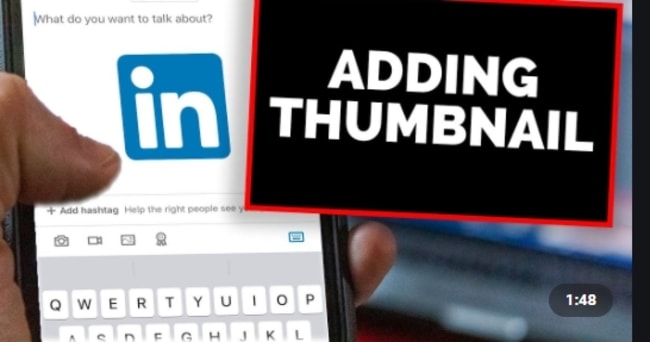
We will guide you through the importance of Linkedin thumbnail, and effective ways to create a thumbnail. Keep reading!!!
In this article
01 [What is a Linkedin Video Thumbnail and Its Size Specifications?](#Part 1)
02 [Publishing Videos On Linkedin](#Part 2)
03 [Ways To Publish Videos On Linkedin](#Part 3)
04 [Importance Of Thumbnails In Linkedin Video](#Part 4)
05 [Tips To Create An Interesting And Effective Linkedin Video Thumbnail](#Part 5)
Part 1 What is a LinkedIn video thumbnail and its size specifications?
A thumbnail for a video is like a preview image of the video and acts like its cover. The viewer will get an idea about what the video contains through its thumbnail image. Though the site chooses the first frame of the video as the thumbnail, you can even set a customized one that is attractive and interesting.
The LinkedIn video thumbnail size specifications are as follows:
● Image size: 1200 X 627 pixels
● Format of the image: JPG or PNG
● Maximum size of the image: 2MB
● Aspect Ratio: The aspect ratio of the thumbnail should match that of the video itself.
Part 2 Publishing videos on LinkedIn
If you are planning to publish a video on LinkedIn, the first thing to know is the place where it will be published. LinkedIn allows adding the videos on the personal feed as well as on the Company pages.
If you are into an established business or a brand having a large number of followers, paid video posts on the company page work best.
For the small- setups and businesses who are looking to promote their products and brands posting a video on the personal feed is a good idea. Initially, you can start by posting on your feed and then can later create a company page.
Part 3 Ways To Publish Videos On Linkedin
After you have decided that whether you will be posting a video on your company page or your personal feed, the next thing is to decide that how the video will be published. There are 3 different ways for posting a video as enlisted below.
● Using YouTube and Vimeo links
If you have your videos on Vimeo or YouTube you can paste their link on your LinkedIn account. To watch the video, a person needs to click on the link and it will then open in the hosting platform.
● Using LinkedIn Native Video
This is the most effective method where a video can be uploaded directly on your LinkedIn account from your system as well as your phone. While posting videos directly on LinkedIn, you can even add customized thumbnails, stickers, subtitles, and titles. A native video will play automatically as it is seen by the people in their feed and thus, they reach a larger number of people.
● Using LinkedIn video ads
To reach the target audience, a sponsored post is also an effective way and the video ads can be posted only through a company page. Depending on the type of product or the brand to be promoted, the video can be created.
Part 4 Importance Of Thumbnails In Linkedin Video
The LinkedIn video thumbnail is one of the important factors that make your video engaging and interesting. Before a person starts watching your video, you need to ensure that they get interested in it and click it. For grabbing this first-time attention, a custom thumbnail works great. You can use any interesting graphic or an image related to your video and edit it to create a customized thumbnail.
A thumbnail can only be used when videos are posted as native LinkedIn videos.
Part 5 Tips To Create An Interesting And Effective Linkedin Video Thumbnail
The following tips will help you create interesting thumbnails for your LinkedIn videos that will grab the viewers’ attention.
● Search for thumbnail templates
There are several sites like Canva, Visme, Postermywall, and others where you can get ready-made templates for creating impressive thumbnails. A variety of designs in different categories are available at these sites to choose from.
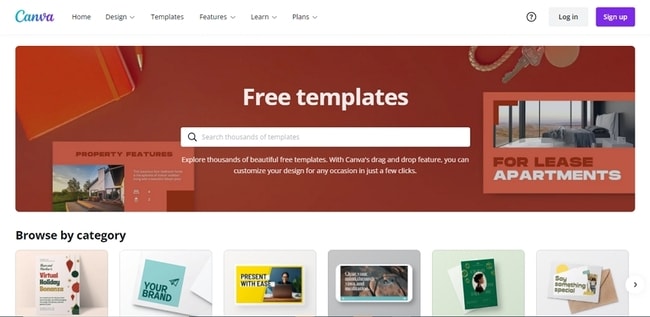
● Edit files using an editing tool
To edit the selected template or a fresh image to be used as a thumbnail, you would need a good editing tool. We recommend Wondershare Filmora Video Editor here as excellent software that can edit your files in multiple ways. The software can be downloaded on your Windows and Mac systems in a hassle-free manner and then multiple editing tools can be used to get the desired thumbnail image. Some of the key features supported by the software include enhancing files with effects, rotating, merging, cropping, flipping, adding text & tiles, adding overlays and filters, transitions and elements, motion tracking, color tuning, and much more.
Wondershare Filmora
Get started easily with Filmora’s powerful performance, intuitive interface, and countless effects!
Try It Free Try It Free Try It Free Learn More >

The interface of the software is simple and the process is fast which makes the software perfect for all types of users.
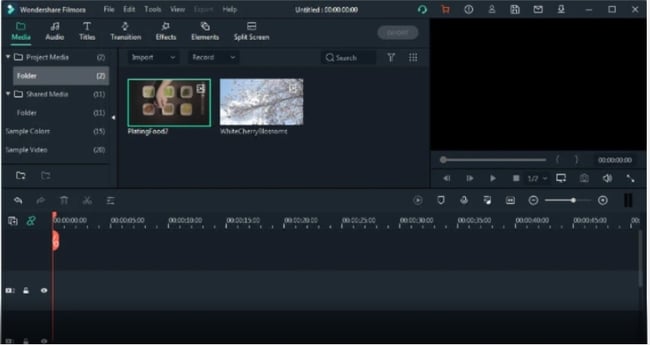
● Keep it simple and uncluttered
The thumbnail should be kept simple and without any clutter. Since LinkedIn is a professional platform there is no need for any unnecessary details needed.
● Let the thumbnail speak of your content
Create a thumbnail that speaks about the content of your video. If the thumbnail is interesting and gives an idea about your video, the viewer will open and watch it.
Key Takeaways from This Episode
● The LinkedIn video thumbnail is a cover image for your videos posted on LinkedIn.
● The videos on LinkedIn can be posted on the company page or as a personal feed.
● The videos can be posted as YouTube or Vimeo links, LinkedIn ads, or as native LinkedIn videos.
● There are several factors to create an effective LinkedIn video thumbnail and one of them is using professional editing software like Wondershare Filmora.
If you have been looking for options to grab the potential of video posting on LinkedIn you are reading on the right page.

We will guide you through the importance of Linkedin thumbnail, and effective ways to create a thumbnail. Keep reading!!!
In this article
01 [What is a Linkedin Video Thumbnail and Its Size Specifications?](#Part 1)
02 [Publishing Videos On Linkedin](#Part 2)
03 [Ways To Publish Videos On Linkedin](#Part 3)
04 [Importance Of Thumbnails In Linkedin Video](#Part 4)
05 [Tips To Create An Interesting And Effective Linkedin Video Thumbnail](#Part 5)
Part 1 What is a LinkedIn video thumbnail and its size specifications?
A thumbnail for a video is like a preview image of the video and acts like its cover. The viewer will get an idea about what the video contains through its thumbnail image. Though the site chooses the first frame of the video as the thumbnail, you can even set a customized one that is attractive and interesting.
The LinkedIn video thumbnail size specifications are as follows:
● Image size: 1200 X 627 pixels
● Format of the image: JPG or PNG
● Maximum size of the image: 2MB
● Aspect Ratio: The aspect ratio of the thumbnail should match that of the video itself.
Part 2 Publishing videos on LinkedIn
If you are planning to publish a video on LinkedIn, the first thing to know is the place where it will be published. LinkedIn allows adding the videos on the personal feed as well as on the Company pages.
If you are into an established business or a brand having a large number of followers, paid video posts on the company page work best.
For the small- setups and businesses who are looking to promote their products and brands posting a video on the personal feed is a good idea. Initially, you can start by posting on your feed and then can later create a company page.
Part 3 Ways To Publish Videos On Linkedin
After you have decided that whether you will be posting a video on your company page or your personal feed, the next thing is to decide that how the video will be published. There are 3 different ways for posting a video as enlisted below.
● Using YouTube and Vimeo links
If you have your videos on Vimeo or YouTube you can paste their link on your LinkedIn account. To watch the video, a person needs to click on the link and it will then open in the hosting platform.
● Using LinkedIn Native Video
This is the most effective method where a video can be uploaded directly on your LinkedIn account from your system as well as your phone. While posting videos directly on LinkedIn, you can even add customized thumbnails, stickers, subtitles, and titles. A native video will play automatically as it is seen by the people in their feed and thus, they reach a larger number of people.
● Using LinkedIn video ads
To reach the target audience, a sponsored post is also an effective way and the video ads can be posted only through a company page. Depending on the type of product or the brand to be promoted, the video can be created.
Part 4 Importance Of Thumbnails In Linkedin Video
The LinkedIn video thumbnail is one of the important factors that make your video engaging and interesting. Before a person starts watching your video, you need to ensure that they get interested in it and click it. For grabbing this first-time attention, a custom thumbnail works great. You can use any interesting graphic or an image related to your video and edit it to create a customized thumbnail.
A thumbnail can only be used when videos are posted as native LinkedIn videos.
Part 5 Tips To Create An Interesting And Effective Linkedin Video Thumbnail
The following tips will help you create interesting thumbnails for your LinkedIn videos that will grab the viewers’ attention.
● Search for thumbnail templates
There are several sites like Canva, Visme, Postermywall, and others where you can get ready-made templates for creating impressive thumbnails. A variety of designs in different categories are available at these sites to choose from.

● Edit files using an editing tool
To edit the selected template or a fresh image to be used as a thumbnail, you would need a good editing tool. We recommend Wondershare Filmora Video Editor here as excellent software that can edit your files in multiple ways. The software can be downloaded on your Windows and Mac systems in a hassle-free manner and then multiple editing tools can be used to get the desired thumbnail image. Some of the key features supported by the software include enhancing files with effects, rotating, merging, cropping, flipping, adding text & tiles, adding overlays and filters, transitions and elements, motion tracking, color tuning, and much more.
Wondershare Filmora
Get started easily with Filmora’s powerful performance, intuitive interface, and countless effects!
Try It Free Try It Free Try It Free Learn More >

The interface of the software is simple and the process is fast which makes the software perfect for all types of users.

● Keep it simple and uncluttered
The thumbnail should be kept simple and without any clutter. Since LinkedIn is a professional platform there is no need for any unnecessary details needed.
● Let the thumbnail speak of your content
Create a thumbnail that speaks about the content of your video. If the thumbnail is interesting and gives an idea about your video, the viewer will open and watch it.
Key Takeaways from This Episode
● The LinkedIn video thumbnail is a cover image for your videos posted on LinkedIn.
● The videos on LinkedIn can be posted on the company page or as a personal feed.
● The videos can be posted as YouTube or Vimeo links, LinkedIn ads, or as native LinkedIn videos.
● There are several factors to create an effective LinkedIn video thumbnail and one of them is using professional editing software like Wondershare Filmora.
If you have been looking for options to grab the potential of video posting on LinkedIn you are reading on the right page.

We will guide you through the importance of Linkedin thumbnail, and effective ways to create a thumbnail. Keep reading!!!
In this article
01 [What is a Linkedin Video Thumbnail and Its Size Specifications?](#Part 1)
02 [Publishing Videos On Linkedin](#Part 2)
03 [Ways To Publish Videos On Linkedin](#Part 3)
04 [Importance Of Thumbnails In Linkedin Video](#Part 4)
05 [Tips To Create An Interesting And Effective Linkedin Video Thumbnail](#Part 5)
Part 1 What is a LinkedIn video thumbnail and its size specifications?
A thumbnail for a video is like a preview image of the video and acts like its cover. The viewer will get an idea about what the video contains through its thumbnail image. Though the site chooses the first frame of the video as the thumbnail, you can even set a customized one that is attractive and interesting.
The LinkedIn video thumbnail size specifications are as follows:
● Image size: 1200 X 627 pixels
● Format of the image: JPG or PNG
● Maximum size of the image: 2MB
● Aspect Ratio: The aspect ratio of the thumbnail should match that of the video itself.
Part 2 Publishing videos on LinkedIn
If you are planning to publish a video on LinkedIn, the first thing to know is the place where it will be published. LinkedIn allows adding the videos on the personal feed as well as on the Company pages.
If you are into an established business or a brand having a large number of followers, paid video posts on the company page work best.
For the small- setups and businesses who are looking to promote their products and brands posting a video on the personal feed is a good idea. Initially, you can start by posting on your feed and then can later create a company page.
Part 3 Ways To Publish Videos On Linkedin
After you have decided that whether you will be posting a video on your company page or your personal feed, the next thing is to decide that how the video will be published. There are 3 different ways for posting a video as enlisted below.
● Using YouTube and Vimeo links
If you have your videos on Vimeo or YouTube you can paste their link on your LinkedIn account. To watch the video, a person needs to click on the link and it will then open in the hosting platform.
● Using LinkedIn Native Video
This is the most effective method where a video can be uploaded directly on your LinkedIn account from your system as well as your phone. While posting videos directly on LinkedIn, you can even add customized thumbnails, stickers, subtitles, and titles. A native video will play automatically as it is seen by the people in their feed and thus, they reach a larger number of people.
● Using LinkedIn video ads
To reach the target audience, a sponsored post is also an effective way and the video ads can be posted only through a company page. Depending on the type of product or the brand to be promoted, the video can be created.
Part 4 Importance Of Thumbnails In Linkedin Video
The LinkedIn video thumbnail is one of the important factors that make your video engaging and interesting. Before a person starts watching your video, you need to ensure that they get interested in it and click it. For grabbing this first-time attention, a custom thumbnail works great. You can use any interesting graphic or an image related to your video and edit it to create a customized thumbnail.
A thumbnail can only be used when videos are posted as native LinkedIn videos.
Part 5 Tips To Create An Interesting And Effective Linkedin Video Thumbnail
The following tips will help you create interesting thumbnails for your LinkedIn videos that will grab the viewers’ attention.
● Search for thumbnail templates
There are several sites like Canva, Visme, Postermywall, and others where you can get ready-made templates for creating impressive thumbnails. A variety of designs in different categories are available at these sites to choose from.

● Edit files using an editing tool
To edit the selected template or a fresh image to be used as a thumbnail, you would need a good editing tool. We recommend Wondershare Filmora Video Editor here as excellent software that can edit your files in multiple ways. The software can be downloaded on your Windows and Mac systems in a hassle-free manner and then multiple editing tools can be used to get the desired thumbnail image. Some of the key features supported by the software include enhancing files with effects, rotating, merging, cropping, flipping, adding text & tiles, adding overlays and filters, transitions and elements, motion tracking, color tuning, and much more.
Wondershare Filmora
Get started easily with Filmora’s powerful performance, intuitive interface, and countless effects!
Try It Free Try It Free Try It Free Learn More >

The interface of the software is simple and the process is fast which makes the software perfect for all types of users.

● Keep it simple and uncluttered
The thumbnail should be kept simple and without any clutter. Since LinkedIn is a professional platform there is no need for any unnecessary details needed.
● Let the thumbnail speak of your content
Create a thumbnail that speaks about the content of your video. If the thumbnail is interesting and gives an idea about your video, the viewer will open and watch it.
Key Takeaways from This Episode
● The LinkedIn video thumbnail is a cover image for your videos posted on LinkedIn.
● The videos on LinkedIn can be posted on the company page or as a personal feed.
● The videos can be posted as YouTube or Vimeo links, LinkedIn ads, or as native LinkedIn videos.
● There are several factors to create an effective LinkedIn video thumbnail and one of them is using professional editing software like Wondershare Filmora.
If you have been looking for options to grab the potential of video posting on LinkedIn you are reading on the right page.

We will guide you through the importance of Linkedin thumbnail, and effective ways to create a thumbnail. Keep reading!!!
In this article
01 [What is a Linkedin Video Thumbnail and Its Size Specifications?](#Part 1)
02 [Publishing Videos On Linkedin](#Part 2)
03 [Ways To Publish Videos On Linkedin](#Part 3)
04 [Importance Of Thumbnails In Linkedin Video](#Part 4)
05 [Tips To Create An Interesting And Effective Linkedin Video Thumbnail](#Part 5)
Part 1 What is a LinkedIn video thumbnail and its size specifications?
A thumbnail for a video is like a preview image of the video and acts like its cover. The viewer will get an idea about what the video contains through its thumbnail image. Though the site chooses the first frame of the video as the thumbnail, you can even set a customized one that is attractive and interesting.
The LinkedIn video thumbnail size specifications are as follows:
● Image size: 1200 X 627 pixels
● Format of the image: JPG or PNG
● Maximum size of the image: 2MB
● Aspect Ratio: The aspect ratio of the thumbnail should match that of the video itself.
Part 2 Publishing videos on LinkedIn
If you are planning to publish a video on LinkedIn, the first thing to know is the place where it will be published. LinkedIn allows adding the videos on the personal feed as well as on the Company pages.
If you are into an established business or a brand having a large number of followers, paid video posts on the company page work best.
For the small- setups and businesses who are looking to promote their products and brands posting a video on the personal feed is a good idea. Initially, you can start by posting on your feed and then can later create a company page.
Part 3 Ways To Publish Videos On Linkedin
After you have decided that whether you will be posting a video on your company page or your personal feed, the next thing is to decide that how the video will be published. There are 3 different ways for posting a video as enlisted below.
● Using YouTube and Vimeo links
If you have your videos on Vimeo or YouTube you can paste their link on your LinkedIn account. To watch the video, a person needs to click on the link and it will then open in the hosting platform.
● Using LinkedIn Native Video
This is the most effective method where a video can be uploaded directly on your LinkedIn account from your system as well as your phone. While posting videos directly on LinkedIn, you can even add customized thumbnails, stickers, subtitles, and titles. A native video will play automatically as it is seen by the people in their feed and thus, they reach a larger number of people.
● Using LinkedIn video ads
To reach the target audience, a sponsored post is also an effective way and the video ads can be posted only through a company page. Depending on the type of product or the brand to be promoted, the video can be created.
Part 4 Importance Of Thumbnails In Linkedin Video
The LinkedIn video thumbnail is one of the important factors that make your video engaging and interesting. Before a person starts watching your video, you need to ensure that they get interested in it and click it. For grabbing this first-time attention, a custom thumbnail works great. You can use any interesting graphic or an image related to your video and edit it to create a customized thumbnail.
A thumbnail can only be used when videos are posted as native LinkedIn videos.
Part 5 Tips To Create An Interesting And Effective Linkedin Video Thumbnail
The following tips will help you create interesting thumbnails for your LinkedIn videos that will grab the viewers’ attention.
● Search for thumbnail templates
There are several sites like Canva, Visme, Postermywall, and others where you can get ready-made templates for creating impressive thumbnails. A variety of designs in different categories are available at these sites to choose from.

● Edit files using an editing tool
To edit the selected template or a fresh image to be used as a thumbnail, you would need a good editing tool. We recommend Wondershare Filmora Video Editor here as excellent software that can edit your files in multiple ways. The software can be downloaded on your Windows and Mac systems in a hassle-free manner and then multiple editing tools can be used to get the desired thumbnail image. Some of the key features supported by the software include enhancing files with effects, rotating, merging, cropping, flipping, adding text & tiles, adding overlays and filters, transitions and elements, motion tracking, color tuning, and much more.
Wondershare Filmora
Get started easily with Filmora’s powerful performance, intuitive interface, and countless effects!
Try It Free Try It Free Try It Free Learn More >

The interface of the software is simple and the process is fast which makes the software perfect for all types of users.

● Keep it simple and uncluttered
The thumbnail should be kept simple and without any clutter. Since LinkedIn is a professional platform there is no need for any unnecessary details needed.
● Let the thumbnail speak of your content
Create a thumbnail that speaks about the content of your video. If the thumbnail is interesting and gives an idea about your video, the viewer will open and watch it.
Key Takeaways from This Episode
● The LinkedIn video thumbnail is a cover image for your videos posted on LinkedIn.
● The videos on LinkedIn can be posted on the company page or as a personal feed.
● The videos can be posted as YouTube or Vimeo links, LinkedIn ads, or as native LinkedIn videos.
● There are several factors to create an effective LinkedIn video thumbnail and one of them is using professional editing software like Wondershare Filmora.
Mastering Titles in FCPX: Essential Skills for Video Editors
How to Add Titles in Final Cut Pro X

Benjamin Arango
Mar 27, 2024• Proven solutions
We add text titles to our projects to tell the audience something they can’t figure out on their own, such as the title of our program, the name of the person speaking, or technical details about a subject.
This is a basic tutorial about Apple Final Cut Pro X, professional video editing software. However, if video editing is new to you, consider Wondershare Filmora for Mac . This is a powerful but easy-to-use tool for users just starting out. Download the free trial version below.
 Download Mac Version ](https://tools.techidaily.com/wondershare/filmora/download/ )
Download Mac Version ](https://tools.techidaily.com/wondershare/filmora/download/ )
Final Cut Pro X has almost 200 different text effects that we can add, but the process of adding titles is essentially the same. Adding titles is what this article is about.
DEFINITIONS
Just to keep us all on the same page, here are my definitions of key terms related to text:
- Text or titles. Words placed on the screen. I use these terms interchangeably.
- Superimpose. Text displayed on the the screen with other video below it. These are also called “supers” or “keys.”
- Full-screen. Text which occupies the entire screen.
- Lower-third. Text which fits below a person talking; in the “lower-third” of the screen.
- Info-graphics. Full-screen text which is superimposed on a graphic, generally used to convey technical information. Typical uses are sports statistics or other information which is easier to convey using text than having someone read the words.
JUST THE BASICS

I’d like to introduce “Yertle,” he’s a sea turtle and the star of this article. (Footage courtesy of Jim Walker and Lobsters Gone Wild Productions.)
At its simplest, we use titles to display his (its?) name.

In the Timeline, put the playhead where you want a title to appear and type Shift+Control+T. This inserts the default lower-third title at the position of the playhead. The title, like almost all titles, has a default duration of 10:00 seconds.

Look at the Browser and see the results of your work. A lower-third title is superimposed over the video in the lower left corner. (I’ll talk about formatting the text in a few paragraphs.)
NOTE: The big limitation of this lower-third title is that it can only be positioned in the left corner. Moving it to the center or right corner requires manual adjustment.
You position or trim a title the same as any video clip: drag the clip to a different location, or drag an edge to change its duration.
Select that title and delete it by pressing the Delete key.

This time, type Control+T and the default full-screen title appears in the center of the screen. Again, this has a default duration of 10 seconds.

If you look right in the center of the screen, you’ll see the word “Title.” Yes, its darn near invisible. And, yes, it looks, um, ugly. However, we have a TON of formatting control to make this look however we want.
Select and delete that full-screen title.
There’s one more way to apply a title: dragging from the Titles Browser.

Click the Title icon in the Toolbar. This displays the contents of the Title Browser. The column on the left displays title categories, the icons on the right indicate individual titles, the search box at the bottom allows you to search for specific titles by name, while the number in the lower right indicates the number of titles currently displayed. (Your number may not match mine because I’ve added a few custom titles to my system.)

Let’s add a totally ridiculous title to our turtle - drag Clouds from the Title Browser and place it above the clip at the point where you want a title to appear.
NOTE: I’m using a marker in the Timeline to help me find the same place in a clip so my screen shots are consistent. Markers are not needed in any way for titles.

Um, yeah. So, some titles look more professional than others… You can delete this title now.
So, we:
- Add titles using keyboard shortcuts
- Drag titles from the Title Browser
- Change position by dragging the title
- Change duration by dragging the edge of the clip
- Delete a title by selecting it and pressing the Delete key
CHANGING TEXT

Add a new full-screen title (type Control+T) to the Timeline. To change the text in a title, double-click it in the Viewer. Here, I’ve changed my title to “An Undersea Adventure.”
NOTE: We can also change the text using the Inspector. I’ll show you how in a few paragraphs. Pick whichever method is easiest for you.
All text, in any title, can be changed by double-clicking it in the Viewer to select it, then typing the new text you want to use.
FORMATTING TEXT

You can format any text that you can select. This means that you can format entire phrases, words, or individual letters differently. For this article, I will format everything the same, because once you know how this works, you can experiment on your own.
Here, I selected my entire title and opened the Inspector (shortcut Cmd+4). Click the Text tab at the top. This section of the Inspector allows you to format the text.
NOTE: The text box near the top of the panel is the second place you can select text for formatting.

If you want a fast way to format text, click the word “Normal” at the top. This displays a menu filled with different text formats. Some of these formats look pretty dreadful; the rest look worse.
NOTE: You can create your own text styles. Refer to the Help for information on how.

The Basic section of the Inspector allows you to change fonts, size, alignment… all the standard font settings we see in other programs. Here, I’ve changed the font to Hobo Std, at 167 points.
While many of these settings you already know there are a few you may not:
- Line spacing. Adjusts the vertical distance between lines within the same paragraph.
- Tracking. Adjusts the horizontal spacing between letters.
- Baseline. Adjusts the vertical spacing of text compared to the horizontal line running thru the center of the white circle in the Viewer.

The Face section allows us to change font color, opacity and blue. Outline and Glow allows us to add, not surprisingly, outlines and glows. You can adjust these as you see fit - I tend not to add outlines or glows.

However, I STRONGLY recommend adding drop shadows to all text that you want viewers to read. Video, even HD video, is low resolution compared to print. Drop shadows make your text much easier to read. These are the settings I recommend for drop shadows.

After making a few changes in the Inspector, here’s the final result. Very cool - and very different from where we started!
ACTION SAFE/TITLE SAFE ZONES
Since television was first invented, we needed to compensate for the differences in TV sets by designing graphics to stay within Action Safe and Title Safe boundaries.
While much of today’s video is designed for the web, your titles will look the best if you follow the same guidelines.
Titles015

Go to the Switch in the Viewer and select “Show Action Safe/Title Safe Zones.”

This displays two pale rectangles in the frame. The outer rectangle is called “Action Safe,” the inner one is called “Title Safe.” Action Safe is 5% in from all edges; Title Safe is 10% in from all edges.
When designing text and graphics for the web, keep all essential elements inside the outer rectangle. When designing graphics and text for broadcast or cable, keep all essential elements inside the inner rectangle.
Here, for example, notice that my title is fully contained within Action Safe.
SUMMARY
Titles give our programs character and personality, plus they explain what’s going on to the audience. Final Cut Pro X provides a wealth of formatting options to make our text look great.

Benjamin Arango
Benjamin Arango is a writer and a lover of all things video.
Follow @Benjamin Arango
Benjamin Arango
Mar 27, 2024• Proven solutions
We add text titles to our projects to tell the audience something they can’t figure out on their own, such as the title of our program, the name of the person speaking, or technical details about a subject.
This is a basic tutorial about Apple Final Cut Pro X, professional video editing software. However, if video editing is new to you, consider Wondershare Filmora for Mac . This is a powerful but easy-to-use tool for users just starting out. Download the free trial version below.
 Download Mac Version ](https://tools.techidaily.com/wondershare/filmora/download/ )
Download Mac Version ](https://tools.techidaily.com/wondershare/filmora/download/ )
Final Cut Pro X has almost 200 different text effects that we can add, but the process of adding titles is essentially the same. Adding titles is what this article is about.
DEFINITIONS
Just to keep us all on the same page, here are my definitions of key terms related to text:
- Text or titles. Words placed on the screen. I use these terms interchangeably.
- Superimpose. Text displayed on the the screen with other video below it. These are also called “supers” or “keys.”
- Full-screen. Text which occupies the entire screen.
- Lower-third. Text which fits below a person talking; in the “lower-third” of the screen.
- Info-graphics. Full-screen text which is superimposed on a graphic, generally used to convey technical information. Typical uses are sports statistics or other information which is easier to convey using text than having someone read the words.
JUST THE BASICS

I’d like to introduce “Yertle,” he’s a sea turtle and the star of this article. (Footage courtesy of Jim Walker and Lobsters Gone Wild Productions.)
At its simplest, we use titles to display his (its?) name.

In the Timeline, put the playhead where you want a title to appear and type Shift+Control+T. This inserts the default lower-third title at the position of the playhead. The title, like almost all titles, has a default duration of 10:00 seconds.

Look at the Browser and see the results of your work. A lower-third title is superimposed over the video in the lower left corner. (I’ll talk about formatting the text in a few paragraphs.)
NOTE: The big limitation of this lower-third title is that it can only be positioned in the left corner. Moving it to the center or right corner requires manual adjustment.
You position or trim a title the same as any video clip: drag the clip to a different location, or drag an edge to change its duration.
Select that title and delete it by pressing the Delete key.

This time, type Control+T and the default full-screen title appears in the center of the screen. Again, this has a default duration of 10 seconds.

If you look right in the center of the screen, you’ll see the word “Title.” Yes, its darn near invisible. And, yes, it looks, um, ugly. However, we have a TON of formatting control to make this look however we want.
Select and delete that full-screen title.
There’s one more way to apply a title: dragging from the Titles Browser.

Click the Title icon in the Toolbar. This displays the contents of the Title Browser. The column on the left displays title categories, the icons on the right indicate individual titles, the search box at the bottom allows you to search for specific titles by name, while the number in the lower right indicates the number of titles currently displayed. (Your number may not match mine because I’ve added a few custom titles to my system.)

Let’s add a totally ridiculous title to our turtle - drag Clouds from the Title Browser and place it above the clip at the point where you want a title to appear.
NOTE: I’m using a marker in the Timeline to help me find the same place in a clip so my screen shots are consistent. Markers are not needed in any way for titles.

Um, yeah. So, some titles look more professional than others… You can delete this title now.
So, we:
- Add titles using keyboard shortcuts
- Drag titles from the Title Browser
- Change position by dragging the title
- Change duration by dragging the edge of the clip
- Delete a title by selecting it and pressing the Delete key
CHANGING TEXT

Add a new full-screen title (type Control+T) to the Timeline. To change the text in a title, double-click it in the Viewer. Here, I’ve changed my title to “An Undersea Adventure.”
NOTE: We can also change the text using the Inspector. I’ll show you how in a few paragraphs. Pick whichever method is easiest for you.
All text, in any title, can be changed by double-clicking it in the Viewer to select it, then typing the new text you want to use.
FORMATTING TEXT

You can format any text that you can select. This means that you can format entire phrases, words, or individual letters differently. For this article, I will format everything the same, because once you know how this works, you can experiment on your own.
Here, I selected my entire title and opened the Inspector (shortcut Cmd+4). Click the Text tab at the top. This section of the Inspector allows you to format the text.
NOTE: The text box near the top of the panel is the second place you can select text for formatting.

If you want a fast way to format text, click the word “Normal” at the top. This displays a menu filled with different text formats. Some of these formats look pretty dreadful; the rest look worse.
NOTE: You can create your own text styles. Refer to the Help for information on how.

The Basic section of the Inspector allows you to change fonts, size, alignment… all the standard font settings we see in other programs. Here, I’ve changed the font to Hobo Std, at 167 points.
While many of these settings you already know there are a few you may not:
- Line spacing. Adjusts the vertical distance between lines within the same paragraph.
- Tracking. Adjusts the horizontal spacing between letters.
- Baseline. Adjusts the vertical spacing of text compared to the horizontal line running thru the center of the white circle in the Viewer.

The Face section allows us to change font color, opacity and blue. Outline and Glow allows us to add, not surprisingly, outlines and glows. You can adjust these as you see fit - I tend not to add outlines or glows.

However, I STRONGLY recommend adding drop shadows to all text that you want viewers to read. Video, even HD video, is low resolution compared to print. Drop shadows make your text much easier to read. These are the settings I recommend for drop shadows.

After making a few changes in the Inspector, here’s the final result. Very cool - and very different from where we started!
ACTION SAFE/TITLE SAFE ZONES
Since television was first invented, we needed to compensate for the differences in TV sets by designing graphics to stay within Action Safe and Title Safe boundaries.
While much of today’s video is designed for the web, your titles will look the best if you follow the same guidelines.
Titles015

Go to the Switch in the Viewer and select “Show Action Safe/Title Safe Zones.”

This displays two pale rectangles in the frame. The outer rectangle is called “Action Safe,” the inner one is called “Title Safe.” Action Safe is 5% in from all edges; Title Safe is 10% in from all edges.
When designing text and graphics for the web, keep all essential elements inside the outer rectangle. When designing graphics and text for broadcast or cable, keep all essential elements inside the inner rectangle.
Here, for example, notice that my title is fully contained within Action Safe.
SUMMARY
Titles give our programs character and personality, plus they explain what’s going on to the audience. Final Cut Pro X provides a wealth of formatting options to make our text look great.

Benjamin Arango
Benjamin Arango is a writer and a lover of all things video.
Follow @Benjamin Arango
Benjamin Arango
Mar 27, 2024• Proven solutions
We add text titles to our projects to tell the audience something they can’t figure out on their own, such as the title of our program, the name of the person speaking, or technical details about a subject.
This is a basic tutorial about Apple Final Cut Pro X, professional video editing software. However, if video editing is new to you, consider Wondershare Filmora for Mac . This is a powerful but easy-to-use tool for users just starting out. Download the free trial version below.
 Download Mac Version ](https://tools.techidaily.com/wondershare/filmora/download/ )
Download Mac Version ](https://tools.techidaily.com/wondershare/filmora/download/ )
Final Cut Pro X has almost 200 different text effects that we can add, but the process of adding titles is essentially the same. Adding titles is what this article is about.
DEFINITIONS
Just to keep us all on the same page, here are my definitions of key terms related to text:
- Text or titles. Words placed on the screen. I use these terms interchangeably.
- Superimpose. Text displayed on the the screen with other video below it. These are also called “supers” or “keys.”
- Full-screen. Text which occupies the entire screen.
- Lower-third. Text which fits below a person talking; in the “lower-third” of the screen.
- Info-graphics. Full-screen text which is superimposed on a graphic, generally used to convey technical information. Typical uses are sports statistics or other information which is easier to convey using text than having someone read the words.
JUST THE BASICS

I’d like to introduce “Yertle,” he’s a sea turtle and the star of this article. (Footage courtesy of Jim Walker and Lobsters Gone Wild Productions.)
At its simplest, we use titles to display his (its?) name.

In the Timeline, put the playhead where you want a title to appear and type Shift+Control+T. This inserts the default lower-third title at the position of the playhead. The title, like almost all titles, has a default duration of 10:00 seconds.

Look at the Browser and see the results of your work. A lower-third title is superimposed over the video in the lower left corner. (I’ll talk about formatting the text in a few paragraphs.)
NOTE: The big limitation of this lower-third title is that it can only be positioned in the left corner. Moving it to the center or right corner requires manual adjustment.
You position or trim a title the same as any video clip: drag the clip to a different location, or drag an edge to change its duration.
Select that title and delete it by pressing the Delete key.

This time, type Control+T and the default full-screen title appears in the center of the screen. Again, this has a default duration of 10 seconds.

If you look right in the center of the screen, you’ll see the word “Title.” Yes, its darn near invisible. And, yes, it looks, um, ugly. However, we have a TON of formatting control to make this look however we want.
Select and delete that full-screen title.
There’s one more way to apply a title: dragging from the Titles Browser.

Click the Title icon in the Toolbar. This displays the contents of the Title Browser. The column on the left displays title categories, the icons on the right indicate individual titles, the search box at the bottom allows you to search for specific titles by name, while the number in the lower right indicates the number of titles currently displayed. (Your number may not match mine because I’ve added a few custom titles to my system.)

Let’s add a totally ridiculous title to our turtle - drag Clouds from the Title Browser and place it above the clip at the point where you want a title to appear.
NOTE: I’m using a marker in the Timeline to help me find the same place in a clip so my screen shots are consistent. Markers are not needed in any way for titles.

Um, yeah. So, some titles look more professional than others… You can delete this title now.
So, we:
- Add titles using keyboard shortcuts
- Drag titles from the Title Browser
- Change position by dragging the title
- Change duration by dragging the edge of the clip
- Delete a title by selecting it and pressing the Delete key
CHANGING TEXT

Add a new full-screen title (type Control+T) to the Timeline. To change the text in a title, double-click it in the Viewer. Here, I’ve changed my title to “An Undersea Adventure.”
NOTE: We can also change the text using the Inspector. I’ll show you how in a few paragraphs. Pick whichever method is easiest for you.
All text, in any title, can be changed by double-clicking it in the Viewer to select it, then typing the new text you want to use.
FORMATTING TEXT

You can format any text that you can select. This means that you can format entire phrases, words, or individual letters differently. For this article, I will format everything the same, because once you know how this works, you can experiment on your own.
Here, I selected my entire title and opened the Inspector (shortcut Cmd+4). Click the Text tab at the top. This section of the Inspector allows you to format the text.
NOTE: The text box near the top of the panel is the second place you can select text for formatting.

If you want a fast way to format text, click the word “Normal” at the top. This displays a menu filled with different text formats. Some of these formats look pretty dreadful; the rest look worse.
NOTE: You can create your own text styles. Refer to the Help for information on how.

The Basic section of the Inspector allows you to change fonts, size, alignment… all the standard font settings we see in other programs. Here, I’ve changed the font to Hobo Std, at 167 points.
While many of these settings you already know there are a few you may not:
- Line spacing. Adjusts the vertical distance between lines within the same paragraph.
- Tracking. Adjusts the horizontal spacing between letters.
- Baseline. Adjusts the vertical spacing of text compared to the horizontal line running thru the center of the white circle in the Viewer.

The Face section allows us to change font color, opacity and blue. Outline and Glow allows us to add, not surprisingly, outlines and glows. You can adjust these as you see fit - I tend not to add outlines or glows.

However, I STRONGLY recommend adding drop shadows to all text that you want viewers to read. Video, even HD video, is low resolution compared to print. Drop shadows make your text much easier to read. These are the settings I recommend for drop shadows.

After making a few changes in the Inspector, here’s the final result. Very cool - and very different from where we started!
ACTION SAFE/TITLE SAFE ZONES
Since television was first invented, we needed to compensate for the differences in TV sets by designing graphics to stay within Action Safe and Title Safe boundaries.
While much of today’s video is designed for the web, your titles will look the best if you follow the same guidelines.
Titles015

Go to the Switch in the Viewer and select “Show Action Safe/Title Safe Zones.”

This displays two pale rectangles in the frame. The outer rectangle is called “Action Safe,” the inner one is called “Title Safe.” Action Safe is 5% in from all edges; Title Safe is 10% in from all edges.
When designing text and graphics for the web, keep all essential elements inside the outer rectangle. When designing graphics and text for broadcast or cable, keep all essential elements inside the inner rectangle.
Here, for example, notice that my title is fully contained within Action Safe.
SUMMARY
Titles give our programs character and personality, plus they explain what’s going on to the audience. Final Cut Pro X provides a wealth of formatting options to make our text look great.

Benjamin Arango
Benjamin Arango is a writer and a lover of all things video.
Follow @Benjamin Arango
Benjamin Arango
Mar 27, 2024• Proven solutions
We add text titles to our projects to tell the audience something they can’t figure out on their own, such as the title of our program, the name of the person speaking, or technical details about a subject.
This is a basic tutorial about Apple Final Cut Pro X, professional video editing software. However, if video editing is new to you, consider Wondershare Filmora for Mac . This is a powerful but easy-to-use tool for users just starting out. Download the free trial version below.
 Download Mac Version ](https://tools.techidaily.com/wondershare/filmora/download/ )
Download Mac Version ](https://tools.techidaily.com/wondershare/filmora/download/ )
Final Cut Pro X has almost 200 different text effects that we can add, but the process of adding titles is essentially the same. Adding titles is what this article is about.
DEFINITIONS
Just to keep us all on the same page, here are my definitions of key terms related to text:
- Text or titles. Words placed on the screen. I use these terms interchangeably.
- Superimpose. Text displayed on the the screen with other video below it. These are also called “supers” or “keys.”
- Full-screen. Text which occupies the entire screen.
- Lower-third. Text which fits below a person talking; in the “lower-third” of the screen.
- Info-graphics. Full-screen text which is superimposed on a graphic, generally used to convey technical information. Typical uses are sports statistics or other information which is easier to convey using text than having someone read the words.
JUST THE BASICS

I’d like to introduce “Yertle,” he’s a sea turtle and the star of this article. (Footage courtesy of Jim Walker and Lobsters Gone Wild Productions.)
At its simplest, we use titles to display his (its?) name.

In the Timeline, put the playhead where you want a title to appear and type Shift+Control+T. This inserts the default lower-third title at the position of the playhead. The title, like almost all titles, has a default duration of 10:00 seconds.

Look at the Browser and see the results of your work. A lower-third title is superimposed over the video in the lower left corner. (I’ll talk about formatting the text in a few paragraphs.)
NOTE: The big limitation of this lower-third title is that it can only be positioned in the left corner. Moving it to the center or right corner requires manual adjustment.
You position or trim a title the same as any video clip: drag the clip to a different location, or drag an edge to change its duration.
Select that title and delete it by pressing the Delete key.

This time, type Control+T and the default full-screen title appears in the center of the screen. Again, this has a default duration of 10 seconds.

If you look right in the center of the screen, you’ll see the word “Title.” Yes, its darn near invisible. And, yes, it looks, um, ugly. However, we have a TON of formatting control to make this look however we want.
Select and delete that full-screen title.
There’s one more way to apply a title: dragging from the Titles Browser.

Click the Title icon in the Toolbar. This displays the contents of the Title Browser. The column on the left displays title categories, the icons on the right indicate individual titles, the search box at the bottom allows you to search for specific titles by name, while the number in the lower right indicates the number of titles currently displayed. (Your number may not match mine because I’ve added a few custom titles to my system.)

Let’s add a totally ridiculous title to our turtle - drag Clouds from the Title Browser and place it above the clip at the point where you want a title to appear.
NOTE: I’m using a marker in the Timeline to help me find the same place in a clip so my screen shots are consistent. Markers are not needed in any way for titles.

Um, yeah. So, some titles look more professional than others… You can delete this title now.
So, we:
- Add titles using keyboard shortcuts
- Drag titles from the Title Browser
- Change position by dragging the title
- Change duration by dragging the edge of the clip
- Delete a title by selecting it and pressing the Delete key
CHANGING TEXT

Add a new full-screen title (type Control+T) to the Timeline. To change the text in a title, double-click it in the Viewer. Here, I’ve changed my title to “An Undersea Adventure.”
NOTE: We can also change the text using the Inspector. I’ll show you how in a few paragraphs. Pick whichever method is easiest for you.
All text, in any title, can be changed by double-clicking it in the Viewer to select it, then typing the new text you want to use.
FORMATTING TEXT

You can format any text that you can select. This means that you can format entire phrases, words, or individual letters differently. For this article, I will format everything the same, because once you know how this works, you can experiment on your own.
Here, I selected my entire title and opened the Inspector (shortcut Cmd+4). Click the Text tab at the top. This section of the Inspector allows you to format the text.
NOTE: The text box near the top of the panel is the second place you can select text for formatting.

If you want a fast way to format text, click the word “Normal” at the top. This displays a menu filled with different text formats. Some of these formats look pretty dreadful; the rest look worse.
NOTE: You can create your own text styles. Refer to the Help for information on how.

The Basic section of the Inspector allows you to change fonts, size, alignment… all the standard font settings we see in other programs. Here, I’ve changed the font to Hobo Std, at 167 points.
While many of these settings you already know there are a few you may not:
- Line spacing. Adjusts the vertical distance between lines within the same paragraph.
- Tracking. Adjusts the horizontal spacing between letters.
- Baseline. Adjusts the vertical spacing of text compared to the horizontal line running thru the center of the white circle in the Viewer.

The Face section allows us to change font color, opacity and blue. Outline and Glow allows us to add, not surprisingly, outlines and glows. You can adjust these as you see fit - I tend not to add outlines or glows.

However, I STRONGLY recommend adding drop shadows to all text that you want viewers to read. Video, even HD video, is low resolution compared to print. Drop shadows make your text much easier to read. These are the settings I recommend for drop shadows.

After making a few changes in the Inspector, here’s the final result. Very cool - and very different from where we started!
ACTION SAFE/TITLE SAFE ZONES
Since television was first invented, we needed to compensate for the differences in TV sets by designing graphics to stay within Action Safe and Title Safe boundaries.
While much of today’s video is designed for the web, your titles will look the best if you follow the same guidelines.
Titles015

Go to the Switch in the Viewer and select “Show Action Safe/Title Safe Zones.”

This displays two pale rectangles in the frame. The outer rectangle is called “Action Safe,” the inner one is called “Title Safe.” Action Safe is 5% in from all edges; Title Safe is 10% in from all edges.
When designing text and graphics for the web, keep all essential elements inside the outer rectangle. When designing graphics and text for broadcast or cable, keep all essential elements inside the inner rectangle.
Here, for example, notice that my title is fully contained within Action Safe.
SUMMARY
Titles give our programs character and personality, plus they explain what’s going on to the audience. Final Cut Pro X provides a wealth of formatting options to make our text look great.

Benjamin Arango
Benjamin Arango is a writer and a lover of all things video.
Follow @Benjamin Arango
Unleash Your Creativity: 8 Top-Notch Mac Video Editors
Many video editors will agree that Apple’s Mac computers are perfect for video editing and other creative media arts such as animation. Unlike, Chrome OS, Windows, or Linux, macOS comes with much-noted preferences. This operating system emphasizes on creativity and design and gives the best producing results with top movie maker software.
8 Stunning Movie Creator for Mac
Browsing through the internet, you will find a myriad of movie maker video editors. However, not every tool is compatible with Mac. If you are getting started with video editing on your Mac, the first step is to choose movie maker software that gives high-quality results. Below, you will find some of the best video editing tools to put out short films and movies professionally.
1. Wondershare Filmora - Best Overall
Filmora by Wondershare is a popular video movie maker for Mac with a wide array of transition, trimming, and overlay options. Notable benefits of using Filmora are modern and advanced features. Also, developers in Filmora consistently introduce new updates and features. For instance, they recently introduced a motion tracking feature. Motion tracking maps objects in a frame and enables the video editor to create texts and graphics that follow that motion. Filmora has a straightforward interface, which makes this tool suitable for beginners as well as professional video editors.
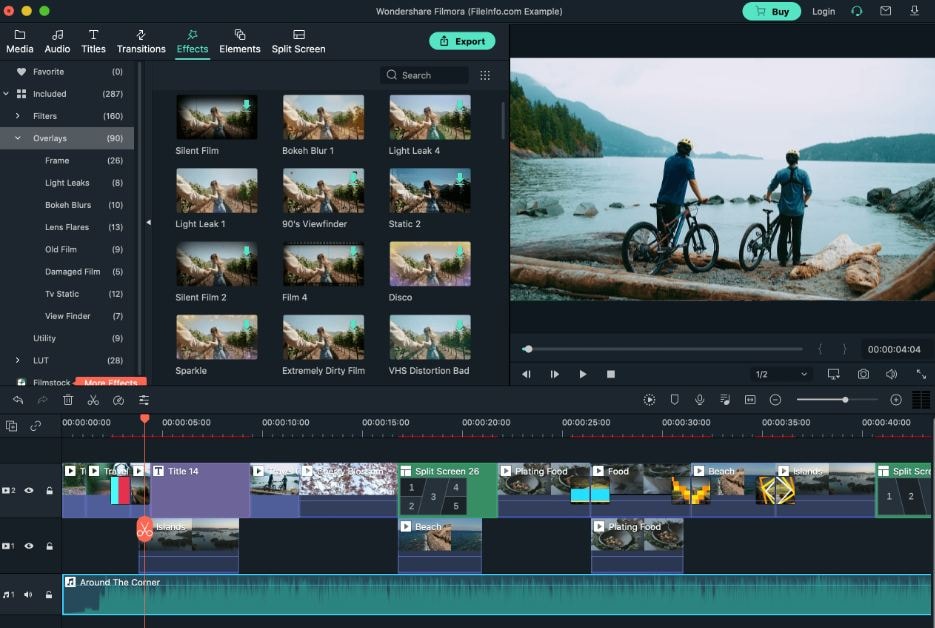
For Win 7 or later (64-bit)
For macOS 10.12 or later
The tool supports 4K videos and offers a plethora of options to add effects, styles, and enable editors to customize videos. Filmora is an affordable tool with many elements and animations. With this tool, editors can insert text and add audio to their videos. Here are some top features offered by Wondershare Filmora:
- Layer multiple video clips
- Video stabilization
- Audio equalizer
- Advanced text editing
- Speed control
- Mosaic (blurring)
- Noise removal
- Screen recording
2. Adobe Premiere Pro – Best for Professionals
Adobe Premiere is another popular platform suitable for video editing. Like Filmora, Adobe Premiere also offers a convenient and simple interface. With embedded layouts, you can use this movie video maker for different purposes. Furthermore, Adobe Premiere also offers complete customization. You can arrange and remove windows and tabs according to your preference.
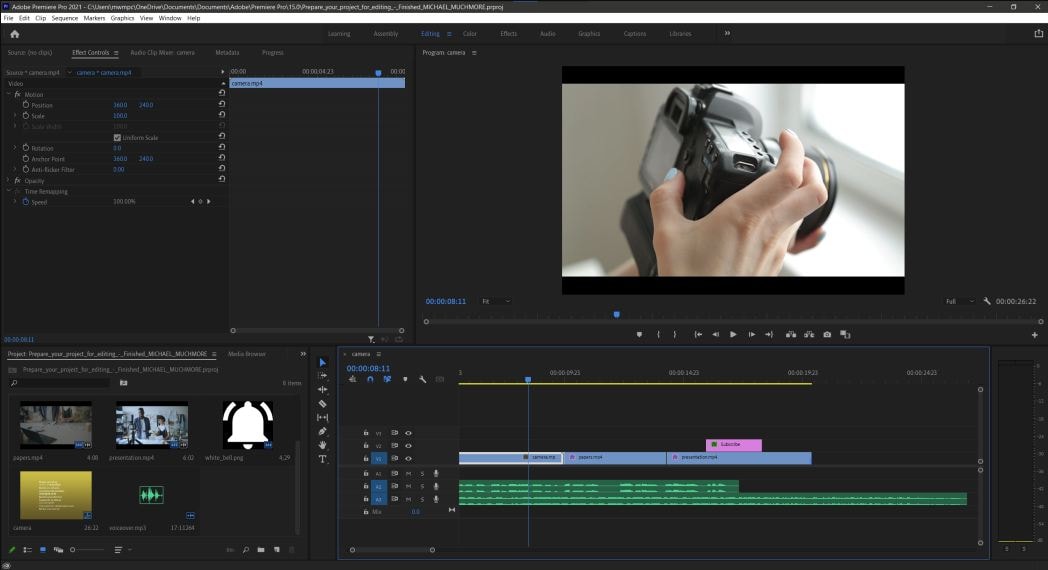
With a great number of presets and codecs, you can easily export videos in different formats. While exporting, you can customize the settings according to your needs, although default settings also offer decent quality. Besides coding formats, Adobe Premiere boasts numerous templates, plug-ins, and scripts to simplify the working process and include professional elements to your video. Exciting features of Adobe Premiere includes:
- Motion graphics templates
- Simultaneous projects
- Transitions
- Effects
- VR rotate sphere
- VR audio editing
- VR editing
- Multiple formats support
3. Shotcut – Best Open Source Software
Shotcut is a simple tool with customized filters that enable you to create collage videos. This movie video maker enables you to adjust video and audio quality and change the volume. Furthermore, you can export videos in different folders such as MJpeg, and WebM.
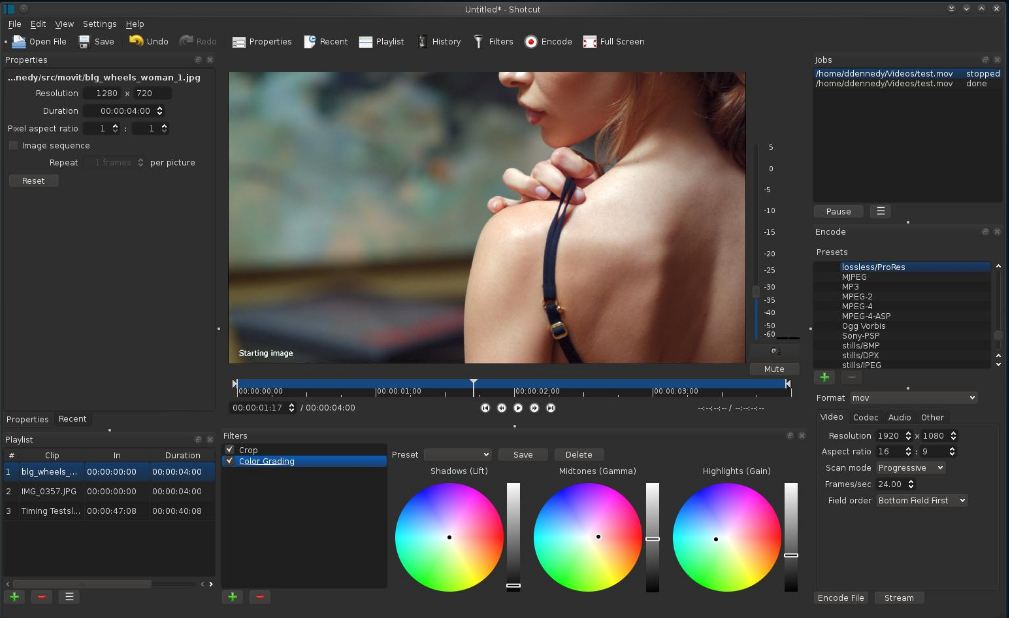
With Shotcut, you can export videos in Lossless mode. This mode keeps the original quality of the videos after the export, which is suitable for professional tasks. This means that you can save time by downloading high-quality videos on default settings. Using this movie creator, you can add filters and effects to enhance the video quality and color grading. Shotcut movie maker offers the following features:
- Multiple audio features
- Video effects
- Hardware support
- Display and monitoring
- Codec independent
- Cross-platform
4. Adobe Premiere Elements – Best for Beginners
Adobe Premiere Elements is a beginners’ version of Premiere Pro. This doesn’t mean that it is less capable, but the tool offers simple features for high-quality tasks. That’s why this video movie makeris highly suitable for beginners. So, if you are just starting with video editing, you should consider trying Premiere elements.
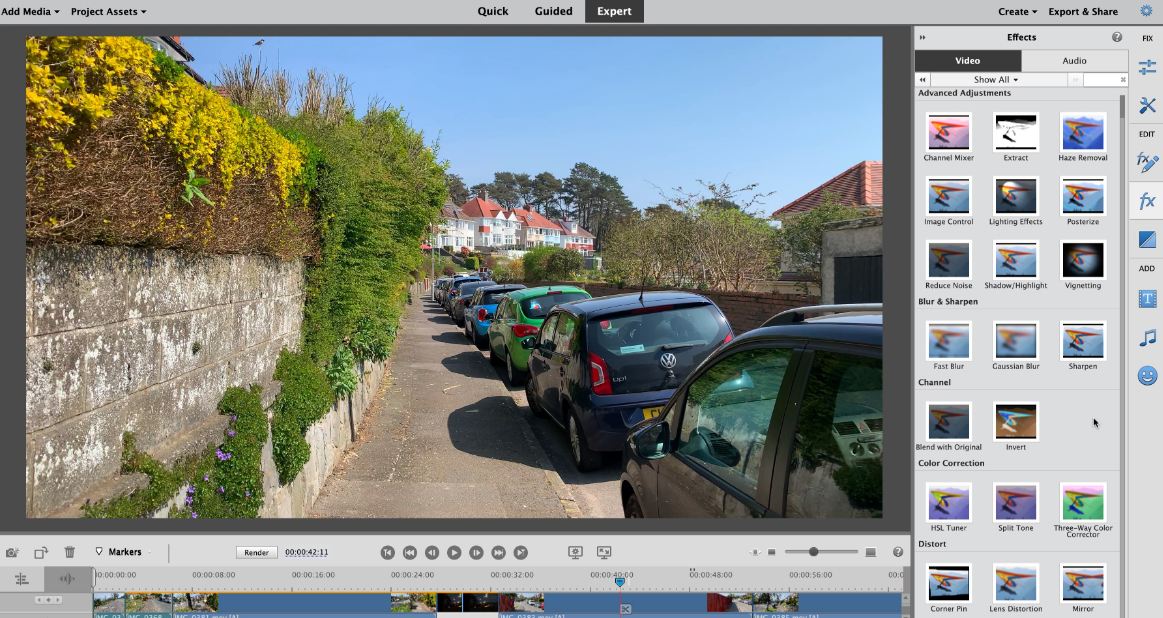
Premiere elements offers a wide array of tools to compile multiple videos, audio, and images into a single video. There are few tools available to scale video quality. This movie video maker is compatible with Mac as well as PC. Premiere Elements also helps you add fun minor effects to maintain flow and spice up the video. The tool uses Sensei AI technology that automatically keeps the important video elements in the frame through re-framing.
If you edit videos for social media platforms, using Adobe Premiere elements would be ideal. It enables you to create a social-friendly square or vertical format of videos. Furthermore, you can include backgrounds, mattes, and motion titles in the videos. Abode Premiere Elements offers the following features:
- Animated overlays
- Auto reframe
- New slideshow styles
- Compress video output
- Shadow and highlight guided edit
- Ample video effects
- Cross-platform support
5. Final Cut Pro – Best Tool for Timeline
Final Cut is a convenient and powerful movie creator tool produced by Apple Company. This platform gives a new approach to video editing and has a flexible Magnetic Timeline. The interface is quite uncommon with fixed windows. You can conveniently add new videos and organize clips with Final Cut Pro, and the video clips you no longer use will easily disappear.
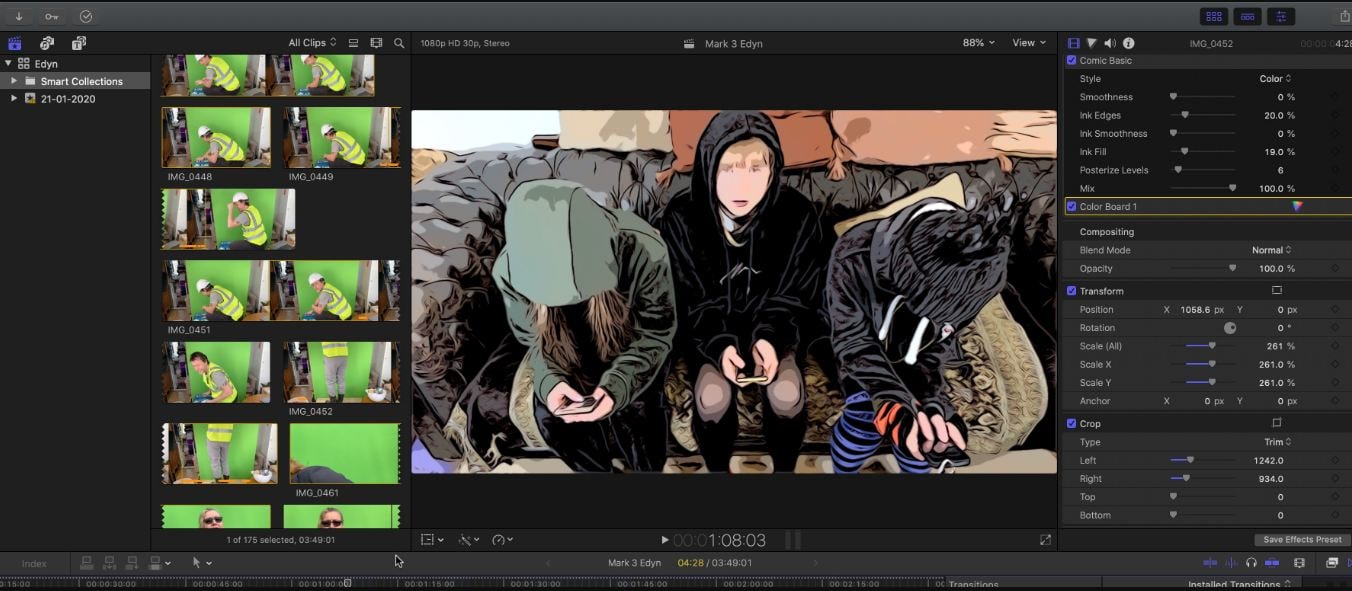
The Clip Connections feature enables you to join basic clips with other elements. The downside of this tool is that you can’t use the keyboard to enter the parameters for color correction. Instead, you have to use a mouse for every modification. This can be overwhelming sometimes, especially for minimum correction. Some features of Final Cut Pro include:
- Supports 360° VR content
- Supports 4K XAVC-S format
- 3D editing
- Motion tracking
- Exports to video ()
6. Blender – Best for 3D
Blender is an open-source and free-to-use movie maker video editor. A notable feature of this tool is 3D rendering. It offers excellent functions to work with movable objects such as animation, opening UV, training, modeling, interface, and shading. The video movie maker offers a highly-technological interface, unlike other similar programs. Blender is perfect for 3D enthusiasts, designers, and artists, as it offers professional 3D quality. Some popular Blender features are:
- Modeling
- Sculpting
- Rendering
- VFX
- Animation and rigging
- Scripting
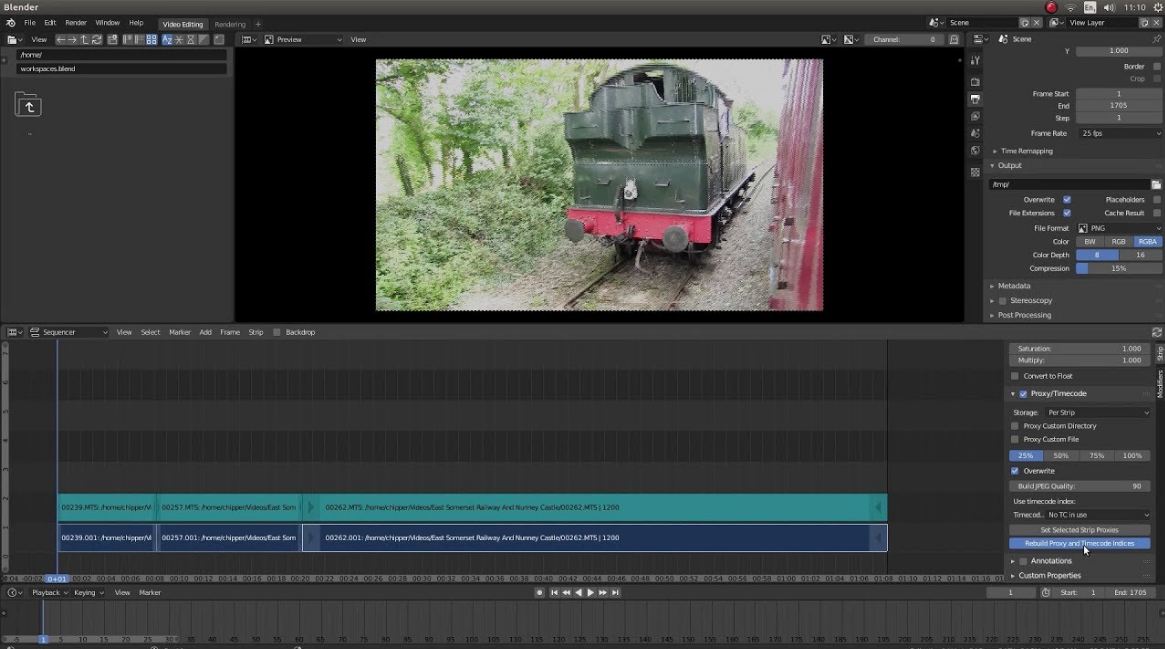
7. OpenShot – Best for Open-Source
OpenShot is another open-source movie video maker but the interface and features are quite different than Blender. It offers drag-and-drop options and a simple interface. This Mac video editing tool creates a perfect balance with simplicity and advanced features. With this tool, you can include wide-ranging transition effects and elements and create high-quality videos. OpenShot offers:
- Desktop integration
- Keyframe animation
- Trim and slice
- Slow-motion and time effect
- Audio waveform
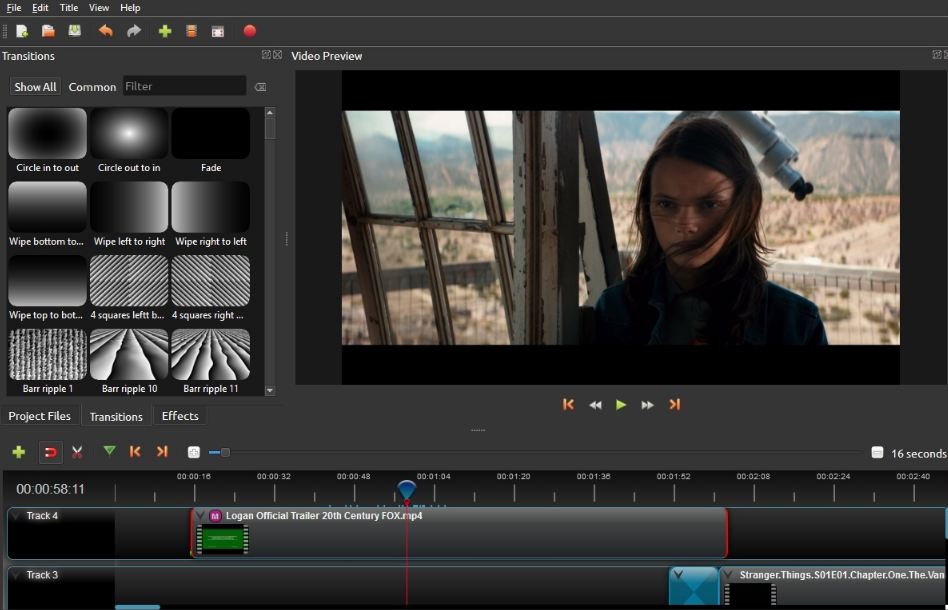
8. Lightworks – Best Tool for Fast Rendering
You can download Lightworks for free on your Mac and include unlimited videos and audio tracks in them. The post-promotion video processing feature performed in real-time saves a tremendous amount of time. With the auto-save feature, you don’t have to worry about losing your progress. Lightworks also offers screen capture features to create YouTube tutorial videos. Features of Lightworks movie maker tool are:
- Unlimited sources
- Live cut
- Unique sync group feature.
- Sync with edits.
- Sync to time code or lock frame
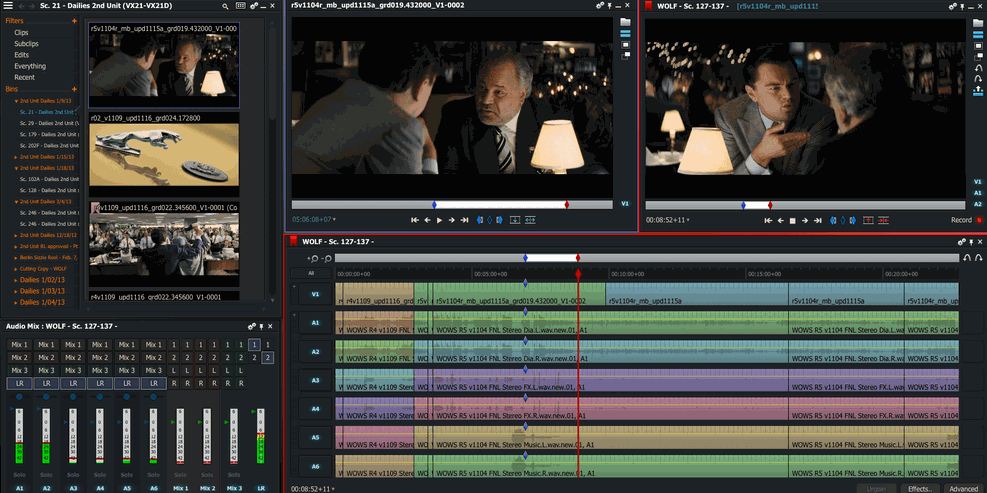
Closing Word
Hopefully, now you can easily choose the best movie maker from the above list and scale your editing skills. Our top pick, Wondershare Filmora is budget-friendly movie maker software with an easy-to-use interface and creative features. There are wide-ranging transitions and effects such as speed blur, ripple and dissolve, making this software a unique option.
Versatile Video Editor - Wondershare Filmora
An easy yet powerful editor
Numerous effects to choose from
Detailed tutorials provided by the official channel
For macOS 10.12 or later
The tool supports 4K videos and offers a plethora of options to add effects, styles, and enable editors to customize videos. Filmora is an affordable tool with many elements and animations. With this tool, editors can insert text and add audio to their videos. Here are some top features offered by Wondershare Filmora:
- Layer multiple video clips
- Video stabilization
- Audio equalizer
- Advanced text editing
- Speed control
- Mosaic (blurring)
- Noise removal
- Screen recording
2. Adobe Premiere Pro – Best for Professionals
Adobe Premiere is another popular platform suitable for video editing. Like Filmora, Adobe Premiere also offers a convenient and simple interface. With embedded layouts, you can use this movie video maker for different purposes. Furthermore, Adobe Premiere also offers complete customization. You can arrange and remove windows and tabs according to your preference.

With a great number of presets and codecs, you can easily export videos in different formats. While exporting, you can customize the settings according to your needs, although default settings also offer decent quality. Besides coding formats, Adobe Premiere boasts numerous templates, plug-ins, and scripts to simplify the working process and include professional elements to your video. Exciting features of Adobe Premiere includes:
- Motion graphics templates
- Simultaneous projects
- Transitions
- Effects
- VR rotate sphere
- VR audio editing
- VR editing
- Multiple formats support
3. Shotcut – Best Open Source Software
Shotcut is a simple tool with customized filters that enable you to create collage videos. This movie video maker enables you to adjust video and audio quality and change the volume. Furthermore, you can export videos in different folders such as MJpeg, and WebM.

With Shotcut, you can export videos in Lossless mode. This mode keeps the original quality of the videos after the export, which is suitable for professional tasks. This means that you can save time by downloading high-quality videos on default settings. Using this movie creator, you can add filters and effects to enhance the video quality and color grading. Shotcut movie maker offers the following features:
- Multiple audio features
- Video effects
- Hardware support
- Display and monitoring
- Codec independent
- Cross-platform
4. Adobe Premiere Elements – Best for Beginners
Adobe Premiere Elements is a beginners’ version of Premiere Pro. This doesn’t mean that it is less capable, but the tool offers simple features for high-quality tasks. That’s why this video movie makeris highly suitable for beginners. So, if you are just starting with video editing, you should consider trying Premiere elements.

Premiere elements offers a wide array of tools to compile multiple videos, audio, and images into a single video. There are few tools available to scale video quality. This movie video maker is compatible with Mac as well as PC. Premiere Elements also helps you add fun minor effects to maintain flow and spice up the video. The tool uses Sensei AI technology that automatically keeps the important video elements in the frame through re-framing.
If you edit videos for social media platforms, using Adobe Premiere elements would be ideal. It enables you to create a social-friendly square or vertical format of videos. Furthermore, you can include backgrounds, mattes, and motion titles in the videos. Abode Premiere Elements offers the following features:
- Animated overlays
- Auto reframe
- New slideshow styles
- Compress video output
- Shadow and highlight guided edit
- Ample video effects
- Cross-platform support
5. Final Cut Pro – Best Tool for Timeline
Final Cut is a convenient and powerful movie creator tool produced by Apple Company. This platform gives a new approach to video editing and has a flexible Magnetic Timeline. The interface is quite uncommon with fixed windows. You can conveniently add new videos and organize clips with Final Cut Pro, and the video clips you no longer use will easily disappear.

The Clip Connections feature enables you to join basic clips with other elements. The downside of this tool is that you can’t use the keyboard to enter the parameters for color correction. Instead, you have to use a mouse for every modification. This can be overwhelming sometimes, especially for minimum correction. Some features of Final Cut Pro include:
- Supports 360° VR content
- Supports 4K XAVC-S format
- 3D editing
- Motion tracking
- Exports to video ()
6. Blender – Best for 3D
Blender is an open-source and free-to-use movie maker video editor. A notable feature of this tool is 3D rendering. It offers excellent functions to work with movable objects such as animation, opening UV, training, modeling, interface, and shading. The video movie maker offers a highly-technological interface, unlike other similar programs. Blender is perfect for 3D enthusiasts, designers, and artists, as it offers professional 3D quality. Some popular Blender features are:
- Modeling
- Sculpting
- Rendering
- VFX
- Animation and rigging
- Scripting

7. OpenShot – Best for Open-Source
OpenShot is another open-source movie video maker but the interface and features are quite different than Blender. It offers drag-and-drop options and a simple interface. This Mac video editing tool creates a perfect balance with simplicity and advanced features. With this tool, you can include wide-ranging transition effects and elements and create high-quality videos. OpenShot offers:
- Desktop integration
- Keyframe animation
- Trim and slice
- Slow-motion and time effect
- Audio waveform

8. Lightworks – Best Tool for Fast Rendering
You can download Lightworks for free on your Mac and include unlimited videos and audio tracks in them. The post-promotion video processing feature performed in real-time saves a tremendous amount of time. With the auto-save feature, you don’t have to worry about losing your progress. Lightworks also offers screen capture features to create YouTube tutorial videos. Features of Lightworks movie maker tool are:
- Unlimited sources
- Live cut
- Unique sync group feature.
- Sync with edits.
- Sync to time code or lock frame

Closing Word
Hopefully, now you can easily choose the best movie maker from the above list and scale your editing skills. Our top pick, Wondershare Filmora is budget-friendly movie maker software with an easy-to-use interface and creative features. There are wide-ranging transitions and effects such as speed blur, ripple and dissolve, making this software a unique option.
Versatile Video Editor - Wondershare Filmora
An easy yet powerful editor
Numerous effects to choose from
Detailed tutorials provided by the official channel
For macOS 10.12 or later
The tool supports 4K videos and offers a plethora of options to add effects, styles, and enable editors to customize videos. Filmora is an affordable tool with many elements and animations. With this tool, editors can insert text and add audio to their videos. Here are some top features offered by Wondershare Filmora:
- Layer multiple video clips
- Video stabilization
- Audio equalizer
- Advanced text editing
- Speed control
- Mosaic (blurring)
- Noise removal
- Screen recording
2. Adobe Premiere Pro – Best for Professionals
Adobe Premiere is another popular platform suitable for video editing. Like Filmora, Adobe Premiere also offers a convenient and simple interface. With embedded layouts, you can use this movie video maker for different purposes. Furthermore, Adobe Premiere also offers complete customization. You can arrange and remove windows and tabs according to your preference.

With a great number of presets and codecs, you can easily export videos in different formats. While exporting, you can customize the settings according to your needs, although default settings also offer decent quality. Besides coding formats, Adobe Premiere boasts numerous templates, plug-ins, and scripts to simplify the working process and include professional elements to your video. Exciting features of Adobe Premiere includes:
- Motion graphics templates
- Simultaneous projects
- Transitions
- Effects
- VR rotate sphere
- VR audio editing
- VR editing
- Multiple formats support
3. Shotcut – Best Open Source Software
Shotcut is a simple tool with customized filters that enable you to create collage videos. This movie video maker enables you to adjust video and audio quality and change the volume. Furthermore, you can export videos in different folders such as MJpeg, and WebM.

With Shotcut, you can export videos in Lossless mode. This mode keeps the original quality of the videos after the export, which is suitable for professional tasks. This means that you can save time by downloading high-quality videos on default settings. Using this movie creator, you can add filters and effects to enhance the video quality and color grading. Shotcut movie maker offers the following features:
- Multiple audio features
- Video effects
- Hardware support
- Display and monitoring
- Codec independent
- Cross-platform
4. Adobe Premiere Elements – Best for Beginners
Adobe Premiere Elements is a beginners’ version of Premiere Pro. This doesn’t mean that it is less capable, but the tool offers simple features for high-quality tasks. That’s why this video movie makeris highly suitable for beginners. So, if you are just starting with video editing, you should consider trying Premiere elements.

Premiere elements offers a wide array of tools to compile multiple videos, audio, and images into a single video. There are few tools available to scale video quality. This movie video maker is compatible with Mac as well as PC. Premiere Elements also helps you add fun minor effects to maintain flow and spice up the video. The tool uses Sensei AI technology that automatically keeps the important video elements in the frame through re-framing.
If you edit videos for social media platforms, using Adobe Premiere elements would be ideal. It enables you to create a social-friendly square or vertical format of videos. Furthermore, you can include backgrounds, mattes, and motion titles in the videos. Abode Premiere Elements offers the following features:
- Animated overlays
- Auto reframe
- New slideshow styles
- Compress video output
- Shadow and highlight guided edit
- Ample video effects
- Cross-platform support
5. Final Cut Pro – Best Tool for Timeline
Final Cut is a convenient and powerful movie creator tool produced by Apple Company. This platform gives a new approach to video editing and has a flexible Magnetic Timeline. The interface is quite uncommon with fixed windows. You can conveniently add new videos and organize clips with Final Cut Pro, and the video clips you no longer use will easily disappear.

The Clip Connections feature enables you to join basic clips with other elements. The downside of this tool is that you can’t use the keyboard to enter the parameters for color correction. Instead, you have to use a mouse for every modification. This can be overwhelming sometimes, especially for minimum correction. Some features of Final Cut Pro include:
- Supports 360° VR content
- Supports 4K XAVC-S format
- 3D editing
- Motion tracking
- Exports to video ()
6. Blender – Best for 3D
Blender is an open-source and free-to-use movie maker video editor. A notable feature of this tool is 3D rendering. It offers excellent functions to work with movable objects such as animation, opening UV, training, modeling, interface, and shading. The video movie maker offers a highly-technological interface, unlike other similar programs. Blender is perfect for 3D enthusiasts, designers, and artists, as it offers professional 3D quality. Some popular Blender features are:
- Modeling
- Sculpting
- Rendering
- VFX
- Animation and rigging
- Scripting

7. OpenShot – Best for Open-Source
OpenShot is another open-source movie video maker but the interface and features are quite different than Blender. It offers drag-and-drop options and a simple interface. This Mac video editing tool creates a perfect balance with simplicity and advanced features. With this tool, you can include wide-ranging transition effects and elements and create high-quality videos. OpenShot offers:
- Desktop integration
- Keyframe animation
- Trim and slice
- Slow-motion and time effect
- Audio waveform

8. Lightworks – Best Tool for Fast Rendering
You can download Lightworks for free on your Mac and include unlimited videos and audio tracks in them. The post-promotion video processing feature performed in real-time saves a tremendous amount of time. With the auto-save feature, you don’t have to worry about losing your progress. Lightworks also offers screen capture features to create YouTube tutorial videos. Features of Lightworks movie maker tool are:
- Unlimited sources
- Live cut
- Unique sync group feature.
- Sync with edits.
- Sync to time code or lock frame

Closing Word
Hopefully, now you can easily choose the best movie maker from the above list and scale your editing skills. Our top pick, Wondershare Filmora is budget-friendly movie maker software with an easy-to-use interface and creative features. There are wide-ranging transitions and effects such as speed blur, ripple and dissolve, making this software a unique option.
Versatile Video Editor - Wondershare Filmora
An easy yet powerful editor
Numerous effects to choose from
Detailed tutorials provided by the official channel
For macOS 10.12 or later
The tool supports 4K videos and offers a plethora of options to add effects, styles, and enable editors to customize videos. Filmora is an affordable tool with many elements and animations. With this tool, editors can insert text and add audio to their videos. Here are some top features offered by Wondershare Filmora:
- Layer multiple video clips
- Video stabilization
- Audio equalizer
- Advanced text editing
- Speed control
- Mosaic (blurring)
- Noise removal
- Screen recording
2. Adobe Premiere Pro – Best for Professionals
Adobe Premiere is another popular platform suitable for video editing. Like Filmora, Adobe Premiere also offers a convenient and simple interface. With embedded layouts, you can use this movie video maker for different purposes. Furthermore, Adobe Premiere also offers complete customization. You can arrange and remove windows and tabs according to your preference.

With a great number of presets and codecs, you can easily export videos in different formats. While exporting, you can customize the settings according to your needs, although default settings also offer decent quality. Besides coding formats, Adobe Premiere boasts numerous templates, plug-ins, and scripts to simplify the working process and include professional elements to your video. Exciting features of Adobe Premiere includes:
- Motion graphics templates
- Simultaneous projects
- Transitions
- Effects
- VR rotate sphere
- VR audio editing
- VR editing
- Multiple formats support
3. Shotcut – Best Open Source Software
Shotcut is a simple tool with customized filters that enable you to create collage videos. This movie video maker enables you to adjust video and audio quality and change the volume. Furthermore, you can export videos in different folders such as MJpeg, and WebM.

With Shotcut, you can export videos in Lossless mode. This mode keeps the original quality of the videos after the export, which is suitable for professional tasks. This means that you can save time by downloading high-quality videos on default settings. Using this movie creator, you can add filters and effects to enhance the video quality and color grading. Shotcut movie maker offers the following features:
- Multiple audio features
- Video effects
- Hardware support
- Display and monitoring
- Codec independent
- Cross-platform
4. Adobe Premiere Elements – Best for Beginners
Adobe Premiere Elements is a beginners’ version of Premiere Pro. This doesn’t mean that it is less capable, but the tool offers simple features for high-quality tasks. That’s why this video movie makeris highly suitable for beginners. So, if you are just starting with video editing, you should consider trying Premiere elements.

Premiere elements offers a wide array of tools to compile multiple videos, audio, and images into a single video. There are few tools available to scale video quality. This movie video maker is compatible with Mac as well as PC. Premiere Elements also helps you add fun minor effects to maintain flow and spice up the video. The tool uses Sensei AI technology that automatically keeps the important video elements in the frame through re-framing.
If you edit videos for social media platforms, using Adobe Premiere elements would be ideal. It enables you to create a social-friendly square or vertical format of videos. Furthermore, you can include backgrounds, mattes, and motion titles in the videos. Abode Premiere Elements offers the following features:
- Animated overlays
- Auto reframe
- New slideshow styles
- Compress video output
- Shadow and highlight guided edit
- Ample video effects
- Cross-platform support
5. Final Cut Pro – Best Tool for Timeline
Final Cut is a convenient and powerful movie creator tool produced by Apple Company. This platform gives a new approach to video editing and has a flexible Magnetic Timeline. The interface is quite uncommon with fixed windows. You can conveniently add new videos and organize clips with Final Cut Pro, and the video clips you no longer use will easily disappear.

The Clip Connections feature enables you to join basic clips with other elements. The downside of this tool is that you can’t use the keyboard to enter the parameters for color correction. Instead, you have to use a mouse for every modification. This can be overwhelming sometimes, especially for minimum correction. Some features of Final Cut Pro include:
- Supports 360° VR content
- Supports 4K XAVC-S format
- 3D editing
- Motion tracking
- Exports to video ()
6. Blender – Best for 3D
Blender is an open-source and free-to-use movie maker video editor. A notable feature of this tool is 3D rendering. It offers excellent functions to work with movable objects such as animation, opening UV, training, modeling, interface, and shading. The video movie maker offers a highly-technological interface, unlike other similar programs. Blender is perfect for 3D enthusiasts, designers, and artists, as it offers professional 3D quality. Some popular Blender features are:
- Modeling
- Sculpting
- Rendering
- VFX
- Animation and rigging
- Scripting

7. OpenShot – Best for Open-Source
OpenShot is another open-source movie video maker but the interface and features are quite different than Blender. It offers drag-and-drop options and a simple interface. This Mac video editing tool creates a perfect balance with simplicity and advanced features. With this tool, you can include wide-ranging transition effects and elements and create high-quality videos. OpenShot offers:
- Desktop integration
- Keyframe animation
- Trim and slice
- Slow-motion and time effect
- Audio waveform

8. Lightworks – Best Tool for Fast Rendering
You can download Lightworks for free on your Mac and include unlimited videos and audio tracks in them. The post-promotion video processing feature performed in real-time saves a tremendous amount of time. With the auto-save feature, you don’t have to worry about losing your progress. Lightworks also offers screen capture features to create YouTube tutorial videos. Features of Lightworks movie maker tool are:
- Unlimited sources
- Live cut
- Unique sync group feature.
- Sync with edits.
- Sync to time code or lock frame

Closing Word
Hopefully, now you can easily choose the best movie maker from the above list and scale your editing skills. Our top pick, Wondershare Filmora is budget-friendly movie maker software with an easy-to-use interface and creative features. There are wide-ranging transitions and effects such as speed blur, ripple and dissolve, making this software a unique option.
Versatile Video Editor - Wondershare Filmora
An easy yet powerful editor
Numerous effects to choose from
Detailed tutorials provided by the official channel
Effortless Reaction Videos: Unleashing the Power of Filmora
How to Make a Reaction Video Easier Than Ever With Filmora

Liza Brown
Mar 27, 2024• Proven solutions
With several video-sharing platforms and billions of videos on those platforms, it is very difficult and competitive to make your mark and have an identity. There are hundreds of categories of videos that you can find on the platforms like Youtube, Dailymotion, Vimeo, and more. Among all those categories, reaction videos are one of the most popular categories. It allows a person to review another person’s opinion, view, or idea about any particular issue or instance. Most of the video-sharing platforms enable their users to make all kinds of reaction videos without any restriction. Having such a huge competition makes it hard to stand out and attract viewers.
Have you ever seen videos where the reactor has a transparent background instead of the rectangle box in the corner? They look nice and engaging, right? The process of making such videos will require so many materials such as a green screen, stand, and other materials to support it. It is difficult for everyone to afford all these and secondly, it is very difficult to carry from one place to another.
With Filmora X, you can create such transparent background reaction videos without such expensive material. Filmora has launched a new feature name AI Portrait that uses artificial intelligence to create amazing and cool effects. It uses the latest technology to separate the background and humans in the footage to help you remove the background with a single click. So, let’s get started with the process of making stunning reaction videos with Filmora’s AI Portrait.
You might be interested in:
Step 01: Open Filmora X. If it is not already installed on your PC, you can download it from here and install it on your PC.

Step 02: Import the video that you want to react to and your reaction video. If you have not already recorded your reaction, then record it first using any camera or smartphone.
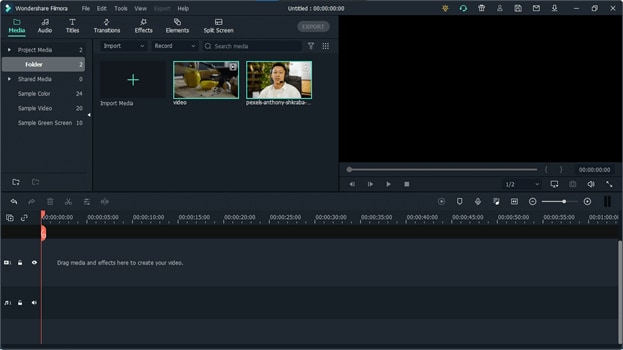
Step 03: Place both of these videos into the timeline. Make sure to place your reaction above.
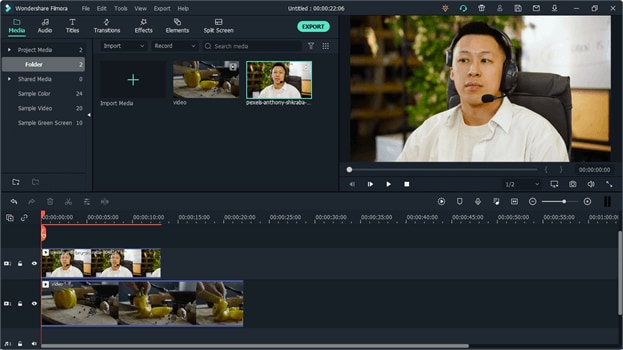
Step 04: Select your reaction video on the timeline and go to the “Effects”. Here you will find a new folder named “AI Portrait”, open it. Here you will find multiple AI portrait effects.
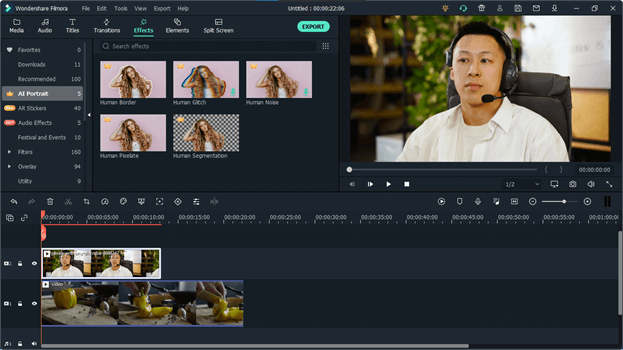
Step 05: Our goal is to remove the background of the reaction. To do that, we will use Human Segmentation. Drag and drop Human Segmentation into the reaction video. If you haven’t purchased this effect already, it will ask you to buy it to export the video. But you want to try it first, click on “Try It.”
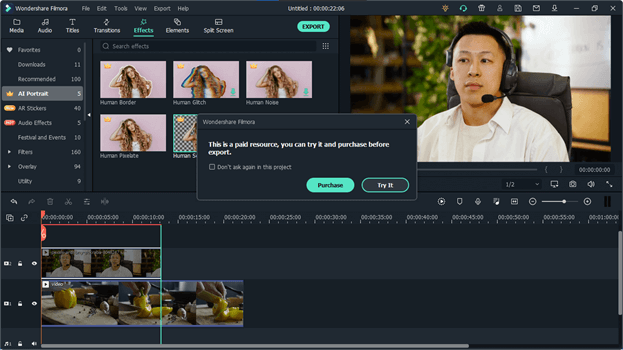
Step 06: Once the effect is successfully applied to the video, its background will be removed automatically.

Step 07: Adjust the video by making it smaller and place it in the bottom left corner of the screen. Your reaction video is ready to be uploaded on video-sharing platforms.
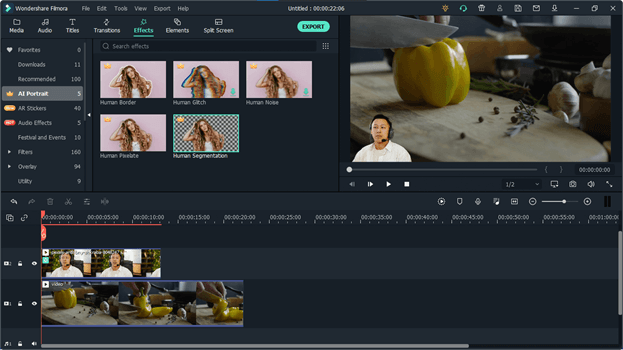
Step 08: To make your video look cool and stunning, you can also add multiple other effects to your reaction. AI portrait allows you to add a border around the character to make it look more visible and separate it from another video. Go to the AI portrait and drag Human Border Effect and drop it into your reaction. It will create an outline around the character and make it look more visible.
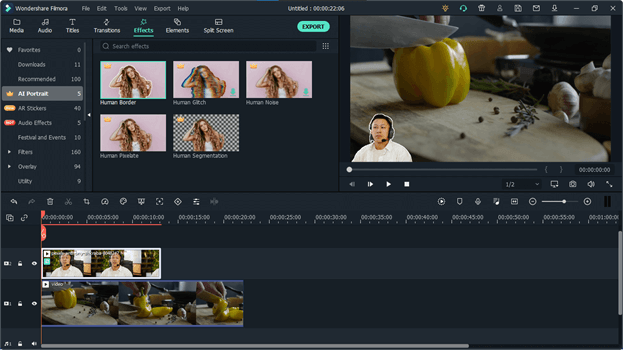
Step 09: In some instances, you might need to change the position or size of your reaction. You can easily do that by applying the Keyframes to it. If you feel like changing the part of your reaction at some point in the video, go to that point in the timeline and click on the keyframe button above the timeline.
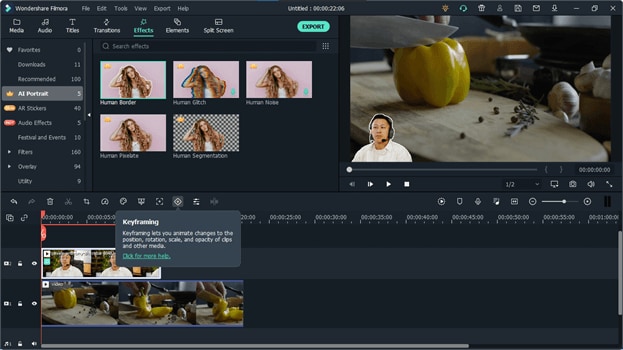
Step 10: Once you click on the keyframe, it will add a keyframe to the video. Now move forward into the timeline to a point and adjust your character’s position by dragging it. Let’s move it to the bottom right corner. It will add another keyframe to the video in the timeline. Now the character will change its position from the left corner to the right corner once it reaches that specific point in time.
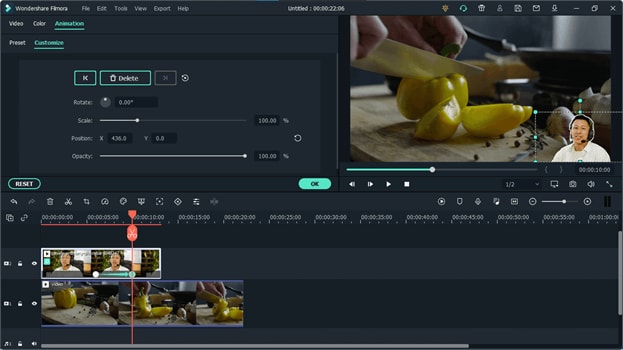
Conclusion
AI Portrait allows you to create wonderful effects using artificial intelligence. This is one of the best uses of AI to make stunning reaction videos. It will not only save you a lot of time but will also help you save a lot of money by helping you remove the background of your video without expensive materials such as a green screen and other materials related to it.

Liza Brown
Liza Brown is a writer and a lover of all things video.
Follow @Liza Brown
Liza Brown
Mar 27, 2024• Proven solutions
With several video-sharing platforms and billions of videos on those platforms, it is very difficult and competitive to make your mark and have an identity. There are hundreds of categories of videos that you can find on the platforms like Youtube, Dailymotion, Vimeo, and more. Among all those categories, reaction videos are one of the most popular categories. It allows a person to review another person’s opinion, view, or idea about any particular issue or instance. Most of the video-sharing platforms enable their users to make all kinds of reaction videos without any restriction. Having such a huge competition makes it hard to stand out and attract viewers.
Have you ever seen videos where the reactor has a transparent background instead of the rectangle box in the corner? They look nice and engaging, right? The process of making such videos will require so many materials such as a green screen, stand, and other materials to support it. It is difficult for everyone to afford all these and secondly, it is very difficult to carry from one place to another.
With Filmora X, you can create such transparent background reaction videos without such expensive material. Filmora has launched a new feature name AI Portrait that uses artificial intelligence to create amazing and cool effects. It uses the latest technology to separate the background and humans in the footage to help you remove the background with a single click. So, let’s get started with the process of making stunning reaction videos with Filmora’s AI Portrait.
You might be interested in:
Step 01: Open Filmora X. If it is not already installed on your PC, you can download it from here and install it on your PC.

Step 02: Import the video that you want to react to and your reaction video. If you have not already recorded your reaction, then record it first using any camera or smartphone.

Step 03: Place both of these videos into the timeline. Make sure to place your reaction above.

Step 04: Select your reaction video on the timeline and go to the “Effects”. Here you will find a new folder named “AI Portrait”, open it. Here you will find multiple AI portrait effects.

Step 05: Our goal is to remove the background of the reaction. To do that, we will use Human Segmentation. Drag and drop Human Segmentation into the reaction video. If you haven’t purchased this effect already, it will ask you to buy it to export the video. But you want to try it first, click on “Try It.”

Step 06: Once the effect is successfully applied to the video, its background will be removed automatically.

Step 07: Adjust the video by making it smaller and place it in the bottom left corner of the screen. Your reaction video is ready to be uploaded on video-sharing platforms.

Step 08: To make your video look cool and stunning, you can also add multiple other effects to your reaction. AI portrait allows you to add a border around the character to make it look more visible and separate it from another video. Go to the AI portrait and drag Human Border Effect and drop it into your reaction. It will create an outline around the character and make it look more visible.

Step 09: In some instances, you might need to change the position or size of your reaction. You can easily do that by applying the Keyframes to it. If you feel like changing the part of your reaction at some point in the video, go to that point in the timeline and click on the keyframe button above the timeline.

Step 10: Once you click on the keyframe, it will add a keyframe to the video. Now move forward into the timeline to a point and adjust your character’s position by dragging it. Let’s move it to the bottom right corner. It will add another keyframe to the video in the timeline. Now the character will change its position from the left corner to the right corner once it reaches that specific point in time.

Conclusion
AI Portrait allows you to create wonderful effects using artificial intelligence. This is one of the best uses of AI to make stunning reaction videos. It will not only save you a lot of time but will also help you save a lot of money by helping you remove the background of your video without expensive materials such as a green screen and other materials related to it.

Liza Brown
Liza Brown is a writer and a lover of all things video.
Follow @Liza Brown
Liza Brown
Mar 27, 2024• Proven solutions
With several video-sharing platforms and billions of videos on those platforms, it is very difficult and competitive to make your mark and have an identity. There are hundreds of categories of videos that you can find on the platforms like Youtube, Dailymotion, Vimeo, and more. Among all those categories, reaction videos are one of the most popular categories. It allows a person to review another person’s opinion, view, or idea about any particular issue or instance. Most of the video-sharing platforms enable their users to make all kinds of reaction videos without any restriction. Having such a huge competition makes it hard to stand out and attract viewers.
Have you ever seen videos where the reactor has a transparent background instead of the rectangle box in the corner? They look nice and engaging, right? The process of making such videos will require so many materials such as a green screen, stand, and other materials to support it. It is difficult for everyone to afford all these and secondly, it is very difficult to carry from one place to another.
With Filmora X, you can create such transparent background reaction videos without such expensive material. Filmora has launched a new feature name AI Portrait that uses artificial intelligence to create amazing and cool effects. It uses the latest technology to separate the background and humans in the footage to help you remove the background with a single click. So, let’s get started with the process of making stunning reaction videos with Filmora’s AI Portrait.
You might be interested in:
Step 01: Open Filmora X. If it is not already installed on your PC, you can download it from here and install it on your PC.

Step 02: Import the video that you want to react to and your reaction video. If you have not already recorded your reaction, then record it first using any camera or smartphone.

Step 03: Place both of these videos into the timeline. Make sure to place your reaction above.

Step 04: Select your reaction video on the timeline and go to the “Effects”. Here you will find a new folder named “AI Portrait”, open it. Here you will find multiple AI portrait effects.

Step 05: Our goal is to remove the background of the reaction. To do that, we will use Human Segmentation. Drag and drop Human Segmentation into the reaction video. If you haven’t purchased this effect already, it will ask you to buy it to export the video. But you want to try it first, click on “Try It.”

Step 06: Once the effect is successfully applied to the video, its background will be removed automatically.

Step 07: Adjust the video by making it smaller and place it in the bottom left corner of the screen. Your reaction video is ready to be uploaded on video-sharing platforms.

Step 08: To make your video look cool and stunning, you can also add multiple other effects to your reaction. AI portrait allows you to add a border around the character to make it look more visible and separate it from another video. Go to the AI portrait and drag Human Border Effect and drop it into your reaction. It will create an outline around the character and make it look more visible.

Step 09: In some instances, you might need to change the position or size of your reaction. You can easily do that by applying the Keyframes to it. If you feel like changing the part of your reaction at some point in the video, go to that point in the timeline and click on the keyframe button above the timeline.

Step 10: Once you click on the keyframe, it will add a keyframe to the video. Now move forward into the timeline to a point and adjust your character’s position by dragging it. Let’s move it to the bottom right corner. It will add another keyframe to the video in the timeline. Now the character will change its position from the left corner to the right corner once it reaches that specific point in time.

Conclusion
AI Portrait allows you to create wonderful effects using artificial intelligence. This is one of the best uses of AI to make stunning reaction videos. It will not only save you a lot of time but will also help you save a lot of money by helping you remove the background of your video without expensive materials such as a green screen and other materials related to it.

Liza Brown
Liza Brown is a writer and a lover of all things video.
Follow @Liza Brown
Liza Brown
Mar 27, 2024• Proven solutions
With several video-sharing platforms and billions of videos on those platforms, it is very difficult and competitive to make your mark and have an identity. There are hundreds of categories of videos that you can find on the platforms like Youtube, Dailymotion, Vimeo, and more. Among all those categories, reaction videos are one of the most popular categories. It allows a person to review another person’s opinion, view, or idea about any particular issue or instance. Most of the video-sharing platforms enable their users to make all kinds of reaction videos without any restriction. Having such a huge competition makes it hard to stand out and attract viewers.
Have you ever seen videos where the reactor has a transparent background instead of the rectangle box in the corner? They look nice and engaging, right? The process of making such videos will require so many materials such as a green screen, stand, and other materials to support it. It is difficult for everyone to afford all these and secondly, it is very difficult to carry from one place to another.
With Filmora X, you can create such transparent background reaction videos without such expensive material. Filmora has launched a new feature name AI Portrait that uses artificial intelligence to create amazing and cool effects. It uses the latest technology to separate the background and humans in the footage to help you remove the background with a single click. So, let’s get started with the process of making stunning reaction videos with Filmora’s AI Portrait.
You might be interested in:
Step 01: Open Filmora X. If it is not already installed on your PC, you can download it from here and install it on your PC.

Step 02: Import the video that you want to react to and your reaction video. If you have not already recorded your reaction, then record it first using any camera or smartphone.

Step 03: Place both of these videos into the timeline. Make sure to place your reaction above.

Step 04: Select your reaction video on the timeline and go to the “Effects”. Here you will find a new folder named “AI Portrait”, open it. Here you will find multiple AI portrait effects.

Step 05: Our goal is to remove the background of the reaction. To do that, we will use Human Segmentation. Drag and drop Human Segmentation into the reaction video. If you haven’t purchased this effect already, it will ask you to buy it to export the video. But you want to try it first, click on “Try It.”

Step 06: Once the effect is successfully applied to the video, its background will be removed automatically.

Step 07: Adjust the video by making it smaller and place it in the bottom left corner of the screen. Your reaction video is ready to be uploaded on video-sharing platforms.

Step 08: To make your video look cool and stunning, you can also add multiple other effects to your reaction. AI portrait allows you to add a border around the character to make it look more visible and separate it from another video. Go to the AI portrait and drag Human Border Effect and drop it into your reaction. It will create an outline around the character and make it look more visible.

Step 09: In some instances, you might need to change the position or size of your reaction. You can easily do that by applying the Keyframes to it. If you feel like changing the part of your reaction at some point in the video, go to that point in the timeline and click on the keyframe button above the timeline.

Step 10: Once you click on the keyframe, it will add a keyframe to the video. Now move forward into the timeline to a point and adjust your character’s position by dragging it. Let’s move it to the bottom right corner. It will add another keyframe to the video in the timeline. Now the character will change its position from the left corner to the right corner once it reaches that specific point in time.

Conclusion
AI Portrait allows you to create wonderful effects using artificial intelligence. This is one of the best uses of AI to make stunning reaction videos. It will not only save you a lot of time but will also help you save a lot of money by helping you remove the background of your video without expensive materials such as a green screen and other materials related to it.

Liza Brown
Liza Brown is a writer and a lover of all things video.
Follow @Liza Brown
Also read:
- New Unlocking the Power of Speech Recognition Text Conversion 101 for 2024
- New In 2024, From Start to Finish How to Edit Video Files on Mac OS X Yosemite
- Updated 2024 Approved Cross-Platform Video Editing 35 Editors That Work Seamlessly Across Devices
- New AVS Video Editor 2023 An In-Depth Analysis and Review for 2024
- Updated The Kids Movie Maker Handbook Tips, Tricks, and Fun for 2024
- In 2024, Shine a Light Best Video Brightness Correction Tools
- Updated 2024 Approved Best Online Video Flippers to Flip Videos Free
- Updated Top Free MP4 Video Cutter Software for Windows and Mac
- Updated Elevate Your Sound 10 Best Professional Audio Editing Programs for 2024
- Updated Simple yet Powerful Video Editors for Learners for 2024
- Updated Achieve Hollywood-Grade Video A Step-by-Step FCPX Guide for 2024
- New The Ultimate Guide to Stop Motion on Instagram From Concept to Viral Sensation for 2024
- 2024 Approved Top Mac Speech-to-Text Apps You Never Knew Existed Free & No Installation
- New 2024 Approved S Best Game Capture Methods Simple and Effective
- No Download? No Problem! The Best Speech to Text Apps for Mac You Need to Try for 2024
- Premiere on Linux? No Problem! 10 Alternative Video Editors for 2024
- New In 2024, 10 Mac-Friendly Video Editing Software Alternatives to Vegas Pro
- Updated 2024 Approved Perfecting Your Facebook Video Cover Tips for Ideal Sizing
- In 2024, Unlock Final Cut Pro at a Steal Explore Education Discounts
- 2024 Approved The Last Wav Converter Tutorial Youll Ever Need
- New 2024 Approved Windows Video Editing Adding Mind-Blowing 3D Effects Made Easy
- New 2024 Approved Free 4K Video Converter Roundup The Best
- Updated In 2024, The Complete AIFF Converter Resource Reviews, Comparisons, and More
- Updated 2024 Approved Online Video Blurring The Top Free Tools and Techniques
- 2024 Approved Unleash Your Creativity GoPro Video Editing on Mac for Beginners
- Updated In 2024, Ultimate Selection Guide Best Android Movie Makers
- Updated In 2024, WhatsApp Status Video Editing Software Free, Paid, and Everything in Between
- New 2024 Approved Unbiased Aiff Converter Reviews Make an Informed Decision
- Silence Is Golden A Step-by-Step Guide to Noise Reduction in FCPX for 2024
- Updated 2024 Approved Easily Cut Large Videos Faster on Mac
- New Transform Your Photos Into Animations with These 7 Essential Tools for 2024
- In 2024, S Hottest Adobe Premiere Title Templates 20 Free Downloads
- 2024 Approved Premiere Pro PC Build A Step-by-Step System Setup Tutorial
- Updated 2024 Approved Edit on the Fly 10 Free Video Speed Changing Apps for Mobile Devices
- Updated 2024 Approved Uncover the Secrets to Converting YouTube Videos to MP3 with Ease
- Updated Trailer Magic Top Video Editing Software for Mac and PC
- Updated In 2024, The Ultimate Guide to Animation Creation Top Software
- New In 2024, 10 Premiere Elements Competitors You Need to Know About This Year
- New In 2024, The Best of Both Worlds Free and Paid Time-Lapse Video Editors
- New 2024 Approved Top-Rated YouTube to MP4 Converters Expert Recommendations
- Updated VN Video Editor Pro Vs. The Competition How Does It Stack Up?
- In 2024, Top Mac Video Editors of Reviews and Comparisons
- New Windows 10 Video Production Best Software Options for 2024
- Updated In 2024, Video Joiner Replacements Top 10 Easy-to-Use Options
- New 2024 Approved Make an Impact Add Slow Motion to Your Videos without Spending a Dime - Filmora
- New In 2024, AIFF Converter Showdown Top Picks and In-Depth Reviews
- What can you do with Face ID on iPhone 14?
- 10 Free Location Spoofers to Fake GPS Location on your Tecno Spark 10 Pro | Dr.fone
- In 2024, Recommended Best Applications for Mirroring Your Motorola Defy 2 Screen | Dr.fone
- New 2024 Approved Ready To Dive Into Photo Talking Videos? Heres What You Need To Know
- Android Screen Stuck General Vivo T2 Pro 5G Partly Screen Unresponsive | Dr.fone
- Nokia 105 Classic Stuck on Screen – Finding Solutions For Stuck on Boot | Dr.fone
- How To Unlink Your iPhone 12 From Your Apple ID
- 3 Ways for Android Pokemon Go Spoofing On Nubia Red Magic 9 Pro+ | Dr.fone
- In 2024, Top 9 Xiaomi 13T Monitoring Apps for Parental Controls | Dr.fone
- Updated 2024 Approved Top 8 Live Selling Platforms & Beginners Tool Suggestion
- In 2024, Guide on How To Remove Apple ID From iPhone 12 Pro Max
- New 2024 Approved A Roster of 8 Top Color Match Generators
- Detailed Review of doctorSIM Unlock Service For Apple iPhone 13 | Dr.fone
- In 2024, Ultimate Guide on Samsung Galaxy M34 FRP Bypass
- Stuck at Android System Recovery Of Samsung Galaxy A24 ? Fix It Easily | Dr.fone
- How to Mirror Your Realme 11 Pro Screen to PC with Chromecast | Dr.fone
- In 2024, How to Bypass Google FRP Lock on Vivo Y100i Power 5G Devices
- Chromebook Users Rejoice The Best Online Video Editing Tools
- How to recover old music from your Honor Magic 6 Pro
- In 2024, Best Pokemons for PVP Matches in Pokemon Go For Honor 100 Pro | Dr.fone
- In 2024, How Do You Unlock your iPhone 6? Learn All 4 Methods
- In 2024, Full Guide to Unlock Apple iPhone 6s with iTunes | Dr.fone
- How To Change Vivo Y02T Lock Screen Clock in Seconds
- Why Does My Vivo S18e Keep Turning Off By Itself? 6 Fixes Are Here | Dr.fone
- In 2024, Android Unlock Code Sim Unlock Your Vivo Y17s Phone and Remove Locked Screen
- Easy Ways to Manage Your Oppo A56s 5G Location Settings | Dr.fone
- Complete Guide to Hard Reset Your Xiaomi 13T | Dr.fone
- Unlock Vivo Y200e 5G Phone Password Without Factory Reset Full Guide Here
- Does find my friends work on ZTE Nubia Flip 5G | Dr.fone
- How to Fix Android App Not Installed Error on Vivo S17e Quickly? | Dr.fone
- In 2024, How to Transfer Data from Realme GT 5 to Samsung Phone | Dr.fone
- In 2024, 10 Fake GPS Location Apps on Android Of your Xiaomi Redmi 12 | Dr.fone
- In 2024, Easy Steps on How To Create a New Apple ID Account On iPhone 15 Pro Max | Dr.fone
- Ways To Find Unlocking Codes For Oppo A79 5G Phones
- New Elevate Your Events with These Video Invitation Creator Apps
- 3 Ways to Track Apple iPhone SE (2022) without Them Knowing | Dr.fone
- In 2024, Easy Fixes How To Recover Forgotten iCloud Password From your Apple iPhone 12 Pro
- Updated Cloning Voices With Hugging Face Features, Guidance, Alternatives for 2024
- How PGSharp Save You from Ban While Spoofing Pokemon Go On Honor Play 40C? | Dr.fone
- In 2024, Top 10 Fingerprint Lock Apps to Lock Your Vivo Y17s Phone
- Undelete lost music from Xiaomi
- What Pokémon Evolve with A Dawn Stone For Nokia 150 (2023)? | Dr.fone
- Updated 2024 Approved FLV Editors for Windows 11/10/8.1/8/7 Easily Edit FLV Videos on PC
- In 2024, How to Transfer Contacts from Tecno Spark 10 Pro to Other Android Devices Using Bluetooth? | Dr.fone
- In 2024, What is the best Pokemon for pokemon pvp ranking On Realme 12 5G? | Dr.fone
- How to Make a Slideshow with Icecream Slideshow Maker
- Title: New In 2024, Make a Lasting Impression How to Design Custom LinkedIn Video Thumbnails
- Author: MdadeLe
- Created at : 2024-04-28 15:03:52
- Updated at : 2024-04-29 15:03:52
- Link: https://smart-video-editing.techidaily.com/new-in-2024-make-a-lasting-impression-how-to-design-custom-linkedin-video-thumbnails/
- License: This work is licensed under CC BY-NC-SA 4.0.


